You will receive an email containing a link allowing you to reset your password to a new preferred one.
Verification mail has been sent.
Please check your mail to verify your account.
Click Here to Login
- How To Reach
- Dates & Price

27°42'14.7"N 88°08'51.4"E
- Kanchenjunga Base Camp Trek

April-May, Sept-Oct
Yuksom, Sikkim

Pickup Point
Bagdogra Airport, Siliguri
Minimum Age
- The trek gives you unmatched views of the majestic Mt. Kanchendzonga, rising up in entirety.
- Follow the popular Goechala trail, winding through dense alpine forests, home to countless floral species.
The Kanchenjunga Base Camp Trek is a doorway to the third highest mountain in the world, and the highest mountain in India, and offers a once in a lifetime glimpse at the mighty Himalayan giant up close. Feel the entanglements of your heart fade away as you witness that first ray of sunlight bathing the peak in a golden hue. Tracing the path to the famous Goecha La Pass, the trail to Kanchenjunga Base Camp winds through pristine alpine forests carpeted by blooming rhododendrons, orchids and other beautiful floral species. Climbing up to over 5,000 meters, the trek exposes you to some extreme temperatures and tricky sections to traverse, but the rewards are worth all the efforts you take. Unfurling under the unwavering gaze of Mt. Kanchenjunga, the Kanchenjunga Base Camp trek is on the top of every trekker's bucket list, as it should be. Come, take a few days off from the maddening monotony of life, and rediscover yourself amidst the sweeping realm of the Himalayas.
Brief Itinerary
Detailed itinerary, day 1 : reaching yuksom, day 2 : trek from yuksom to bakhim, day 3 : trek from bakhim to phedang, day 4 : trek from phedang to dzongri, day 5 : acclimatisation day at dzongri; excursion to laxmi pokhari, day 6 : trek from dzongri to bikhbari, day 7 : acclimatisation day; excursion to chaurikhang & rathong glacier, day 8 : trek from bikhbari to bakhim, day 9 : trek from bakhim to yuksom, day 10 : drive from yuksom to siliguri.
We can arrange a cab for you from the pickup point in Siliguri/NJP/Bagdogra Airport, the charges for the same are not included in the package. The cost of the cab can be shared among the trekkers joining the trek. For communications purposes, we will create a Whatsapp Group before the departure date of the trek and will share the details regarding the transportation. The drop at Siliguri after the trek will be arranged in a similar way.
How to reach Kanchenjunga Base camp Trek Starting Point (Yuksom) :
Bagdogra Airport is the nearest airport, from here you can take a taxi/bus to Yuksom. If you are a large group then a minivan or a minibus can be arranged easily.
New Jalpaiguri Station located at a distance of 150 km from Yuksom, from the station you can take taxi/bus to Yuksom.
Latest Stories
Why trek with us .

Fixed Departures All
Get yourself fit, nutrition tips, things to take, health & safety.
- Accommodations at Trek: All accommodations on the trek will be on twin sharing basis in Tents or Homestays. Any accommodation in a hotel/guest house/hostel will be in a budget hotel.
- Trek Leader and Guides: An experienced and certified Trek Leader , as well as a professional guide, will accompany you for the trek. The team will have years of experience and well equipped for any emergency situation.
- Services of a Professional Trekking Team: A team of an experienced Cook, Camp Staff, Porters/Mules will accompany you for all the arrangements on the trek .
- Meals: All Meals on the Trek are included. We will serve Vegetarian Indian food on the trek which will be cooked by our high altitude chefs. It will be a five-course meal plan.
- Camping and Safety Equipment: All the camping equipment such as Tents, Sleeping bags, Toilet Tents, Dining Tent, Mattresses, and other things will be provided by us and we guarantee the quality. Safety Equipment including Medical kit, Oxygen Cylinder, Oximeter, Crampons & Gaiters(if required) will be provided by us. We recommend you to bring your own sleeping bags if possible.
- Trek Permits and Forest Camping Charges: Only for Indian Clients, All the applicable trekking permits, Camping Charges, Forest Entry Fee, etc will be paid by us. Foreigners have to pay these charges if not mentioned.
- A Life-Changing Experience: We assure you that by trekking in the Himalayas you will have a life-changing experience and we will do everything we can to provide you with the best services and make your venture in the wild an unforgettable one.
Note: Prior to booking any adventure with Trekmunk, it will be mandatory to sign the waiver form and get a medical certificate from a doctor in due time, without these, you will not be allowed to start the trek. All this will be done online without using any paper.
- GST and Other Taxes: The goods and services tax is not included in the price mentioned with the trek. They are subjected to change according to the government rules of India.
- Accommodation and Food in Siliguri: Food and stay in Siliguri is not included in the package.
- Flights and Transportation to and fro base camp: Flights or other means of transport are not included in the package. Transportation from Siliguri to Yuksom and back to Siliguri is not included in the package . We can arrange a cab for you according to your requirements but you will be liable to pay for the same. Any expenses occurred during the journey are not included in the package cost.
- Personal Equipment: Your Rucksack, personal clothing, shoes, trek poles, and other personal trekking gear is not included in this package. You have to bring your own gear according to the weather and difficulty of the trek.
- Portage of Personal Bags(Offloading): We highly advise you to carry your own burden (your rucksack) but due to any reason, if you wish to not carry your rucksack, we can arrange for a porter/mule to carry it. For this service, you will be charged over and above the trek cost. The charges for offloading vary with every trek.
- Travel Insurance: Travel Insurance is not included in this package. We recommend you to have travel insurance before opting for such adventures. You can buy insurance from us while booking the trek, it is optional.
- Personal Expenses: Any personal expenses incurred (Laundry, Bottled Water, Beverages, Snacks, Orders at tea houses or dhabas, Tips for guides, Camera fees, etc) are not included in the package.
- Emergency Expenses: Any costs arising out of unforeseen circumstances such as accidents, bad weather, landslides, road conditions and any other circumstances beyond our control are not included in the package.
- Anything not mentioned in Inclusions of the package.
Cancellation Policy And More Information
Booking terms:, confirmation policy:.
Upon Booking, An invoice will be sent to your mail & within 12 to 24 hours the booking confirmation with additional details will be sent to your mail.
Cancellation Policy:
This image is only a brief visual representation of the policy.
Please read the detailed policy carefully by clicking on this text.
_1655191763393.jpg)
Refund Policy:
Any refund applicable will be processed within 10 to 15 business days as per the company policy.
Postpone/Transfer of a booked trek:
a) You can postpone your booked trek for a period of two months (61 days) but Trekmunk will charge a 20% processing fee. The last date for the postponement will be 15 days before the start of the trek. You can book any slot for the same trek in the next 2 months (61 days) which will totally depend on the availability. You will have to confirm your slot for your future trek 15 days prior to that trek. Failing to book the slot in 2 months (61 days) time, would be considered a cancellation with no refund of any kind. The 2 months (61 days) time frame will be from the start date of the initial trek you booked for. Postponing a booked trek can only be done once. If it is postponed 45 days before the departure date, we will not charge any fee.
b) You can transfer your booked slot for the trek to any fit person till 15 days before the trek. You just have to mail us the request and rest we will handle. The new person has to get all the mandatory documents duly signed for the trek and is bound with this booking contract. It is the participant's responsibility to read and agree to all these terms.
More Information:
1. We Trek for a Cause: For overall development of the areas we run our operations in, we donate Rs 100/- per booking from our profits which are used for the upliftment of the local people and conserving nature. We have named this initiative as - Trek for a Cause. For more details, follow: https://www.trekmunk.com/trek-for-a-cause
2. We are paperless: We are focusing on Sustainable Tourism and to do that we are trying all measures to convert our trek operations to be Eco-Friendly. Going Paperless is one step closer to our aim.
3. Single-Use Plastic: Trekmunk does not encourage the use of single-use plastic items. We are ensuring that our team is working together to reduce the problem and educate those around them. We will send you instructions on how to go plastic-free on your adventures.
4. Preparing for your Holiday: Getting some additional exercise makes a lot of sense to spend time before coming on a trekking adventure. The fitter you are, the more enjoyable you will find the experience. Hiking in the hill country is the best training but jogging, squash and swimming are also good for developing cardiovascular fitness and stamina. To read more on how to get fit, follow: https://www.trekmunk.com/get-fit-for-trek
5. Electricity Supply & Plug: You will get electricity supply till the starting point of the trek. If not Indian, We recommend you check if you require an adaptor for your electrical items at: http://www.worldstandards.eu/electricity/plugs-and-sockets/
6. Currency: The unit of currency in India is the Indian Rupees.
7. Health & Vaccinations:
Severe Allergies: If you have a severe allergy please inform the Trekmunk office before you travel. We will do all we can to help, but we cannot guarantee an allergy-free environment on trekmunk trips. You will need to carry your own treatment for the allergy with you, as 'adrenaline auto-injectors' are not carried as standard by our leaders and staff. You should inform your leader on the arrival of your allergy, and let them know where you keep your adrenaline pen.
Vaccinations: You should contact your doctor or travel clinic to check whether you require any specific vaccinations or other preventive measures. You should be up to date with routine courses and boosters as recommended e.g. diphtheria-tetanus-polio and measles-mumps-rubella, along with hepatitis A and typhoid. Malarial prophylaxis is not usually required for trips in the mountains, however, if you are visiting rural and remote low lying areas then they might be necessary.
8. Passport & Visas/Identity Proofs: If foreigner, Validity for 6 months, should have blank pages, and should be kept with yourself all the time.
9. Water: If you are on a trekking or cycling holiday, water is supplied to fill up your individual bottles. This will be boiled or filtered. Additionally, you should take purification tablets or a filter bottle (such as a LifeStraw, Sawyer Filter) to treat your water when in towns or where water is not supplied. We do not encourage the purchasing of single-use plastic bottles.
10. Altitude: This adventure involves going to a very high altitude. This is not something that you should worry about; the human body is quite capable of adapting to a very wide range of altitudes, but it is important that we follow some simple rules in order to acclimatize successfully. We will send you the information in your mailbox about Acute Mountain Sickness and trekking in high altitudes. On this trip, we carry bottled oxygen for use in emergencies.
11. Guidance on Tipping: Tipping is the accepted way of saying thank you for good service. Normally the guide and any other trek staff are given their tips at the end of the trek and this is best done as a group. The main guide will make sure that the tip is appropriately distributed among all the staff members on the trek.
12. Spending/Emergency Money: Approximately Rs. 8000-10000/- (in Indian Currency)should be carried for miscellaneous expenses including porter and trek crew tips, drinks, soft drinks, etc. We recommend that you carry your travel money in the form of cash as the availability of ATM is less in these remote areas. This can also serve as your emergency spending money.
13. Travel Insurance: It is recommended to have travel insurance for these kinds of adventures. When taking out insurance please ensure the policy you choose covers you for the activities and altitude included in your itinerary. We will ask for the Travel Insurance Details over a mail. Indians can buy insurance from us while booking the trek.
I was bored with my regular 9 to 5 schedule and then I decided to seclude myself from the chaotic city life. So, I went to Brahmatal trek last month along with a couple of my friends. We went with Trekmunk and it was a lovely experience. The trek guide, Ramesh was very polite and ...
I had the best time of my life at Sandakhphu Phalut trek arranged by Trekmunk. Literally I felt like I was in heaven and I was soo very happy. I will recommend everyone to opt for Trekmunk. I was a solo woman traveler and was a bit worried, but things went very smoothly and I en ...
Chadar trek is considered to be one of the most difficult and dangerous treks, which requires a lot of skilled trek leaders, a perfect guide and a strong team of porters. I choose Trekmunk for Chadar and they proved they are a perfect team. Highly skilled trek leaders, profession ...
I was bored with my regular 9 to 5 schedule and then I decided to seclude myself from the chaotic city life. So, I went to Brahmatal trek last month along with a couple of my friends. We went with Trekmunk and it was a lovely experience. The trek guide, Ramesh was very polite and helpful. The food and snacks were amazing. The activities in the campsite during our overnight stay is something that I am gonna cherish my entire life. I am waiting for my next trek with Trekmunk.
I had the best time of my life at Sandakhphu Phalut trek arranged by Trekmunk. Literally I felt like I was in heaven and I was soo very happy. I will recommend everyone to opt for Trekmunk. I was a solo woman traveler and was a bit worried, but things went very smoothly and I enjoyed it a lot. I miss my fellow trekkers too. I am very satisfied with their arrangements.
Chadar trek is considered to be one of the most difficult and dangerous treks, which requires a lot of skilled trek leaders, a perfect guide and a strong team of porters. I choose Trekmunk for Chadar and they proved they are a perfect team. Highly skilled trek leaders, professional skiers, gave us details on how to walk on slippery ice. Professionally trained and certified with wilderness medication programs always ready to take your care in any condition and travelers themselves. One will enjoy their company, their travel stories and their way of leading a trek. Cheers to team Trekmunk.
Traveling with these people is surely an insanely enthralling experience. This is my second backpacking trip with these people and the way I had imagined backpacking to be has been fulfilled by them and they have given me surely more. The best thing about travelling with these people is that you understand the true meaning of travelling and experience it very closely. You are given great freedom but at the same time taking care of. You participate in the process of backpacking. You have a trip leader with you but he acts more like a friend as the days pass by! We attended the hornbill festival and did a wonderful trek to Dzukuo valley in Nagaland with the leadership of this group. You break the boundaries of yourself when you travel like a true traveller and that is possible with these people.
I had the most wonderful experience trekking through the ranges of Chandrashila with Trekmunk. The small moments of achievement were phenomenal. Chandrashila is the most astonishing peak that I've ever trekked through; I've never been so fascinated. I think I am going to go for another trek with Trekmunk soon enough! The kind of hospitality that is provided to us is worth appreciating. I made many new friends and have enjoyed each and every day of this trek to its fullest.

Related Blogs
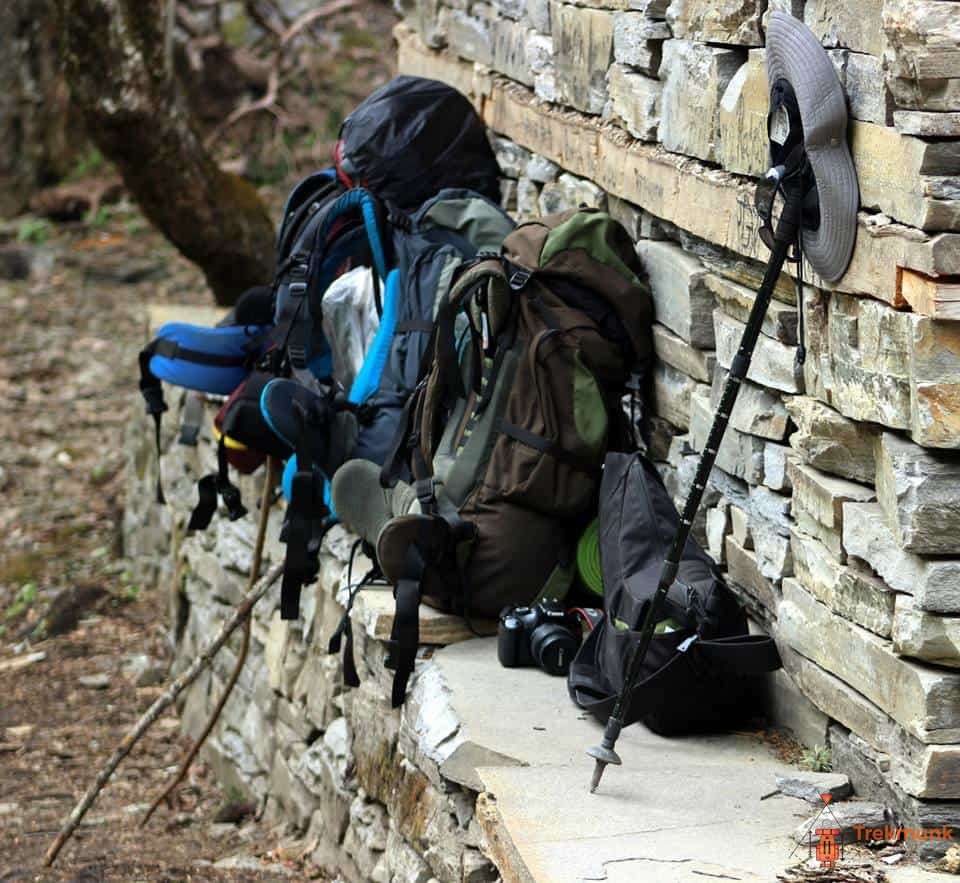
Related Tours

Goechala Trek
Kanchenjunga round trek.

Sandakphu & Phalut Trek

Singalila Ridge Trek

"Trekmunk is changing the indian trekking industry"
"10 Most Promising Adventure Sporting and Trekking Companies - 2020"

" Things you do for the Passion for Travel"
Hello there, How can we help you ?
Timing: 10 am to 6 pm IST (GMT +5:30)
Whats App Us
- Last Minute
- About KE Adventure
- KE Office Team
- Awards & Accolades
- The KE Experience
- Grades Explained
- Flight Information
- Booking with KE
- Travel Insurance
- Booking Conditions
- Frequently Asked Questions
- Book with Confidence
- Sustainability
- Climate Change
- Carbon Absorption
- Partnerships and charity
- Sustainable Travel
- Enquire now
- Canary Islands
- Czech Republic
- Netherlands
- North Macedonia
- Switzerland
- United Kingdom
- South Korea
- Reunion Island
- Sierra Leonne
- South Africa
- New Zealand
- Papua New Guinea
- El Salvador
- French Guiana

The world’s best walking routes from leisurely footpaths to challenging trails.

Road, mountain, adventure and leisure cycling holidays across the globe.

Taking you high into the world's most spectacular mountain ranges.

Active journeys focusing on the cultural highlights of a country.

Wildlife experiences and safaris to see the world's most incredible animals.

Fun-filled adventures to share with all the family, led by specialist leaders.

Discover the unique wilderness landscapes and wildlife of the Arctic and Antarctica.

Thrilling snowy escapes away from the downhill crowds.
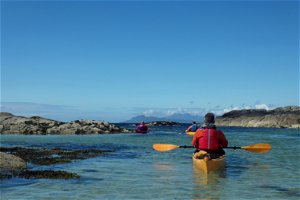
Explore the world from a different perspective on one of these adventures.
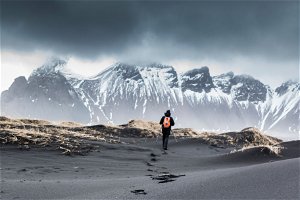
Unique, expedition-style trips; adventures you never knew existed.

Small group holidays led by fantastic local KE leaders.

Travel at your own pace while we arrange all the logistics.

Experience our guided adventures, exclusively for your friends and family

Join like-minded travellers on our guided group adventures, or travel Self-Guided.
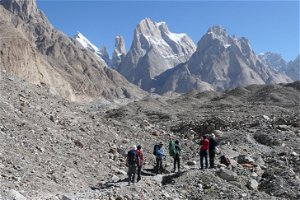
Encapsulating the spirit of KE from the past 40 years of adventure travel.
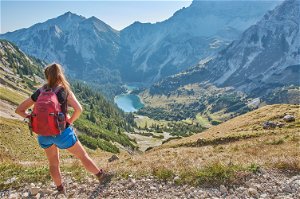
An adventurers playground, from quaint alpine villages to towering peaks.
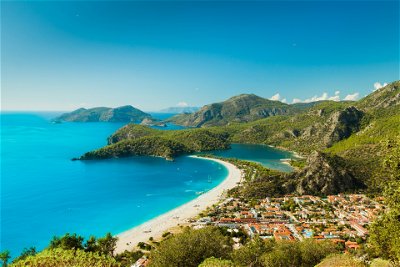
Gaze out to sea and follow rugged trails past golden beaches.
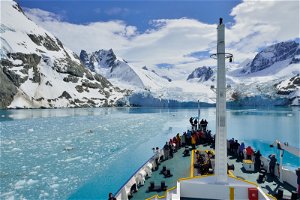
Once-in-a-lifetime adventure across the frozen oceans.
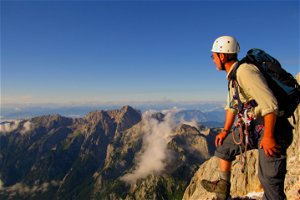
For the peak-baggers! Climb the highest peak in each country.
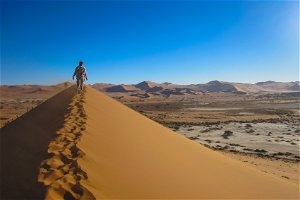
Incredible landscape by day, stargaze the endless sky by night.
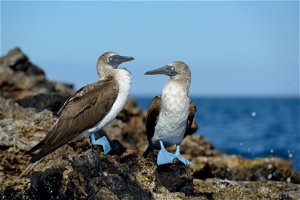
Island-hopping in the Galapagos to the Canaries to the paradise trails of Bali.
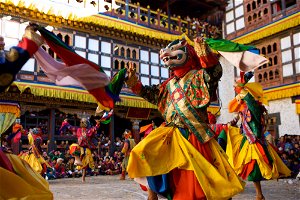
Timing your holiday right to coincide with a local festival.
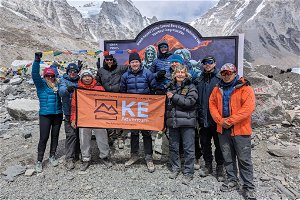
Step into one of our best-selling adventures.
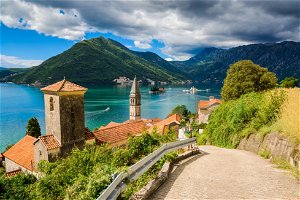
Enjoy the fabulous climate, food and routes all around The Med.
Sikkim - Beneath Kangchenjunga Trek
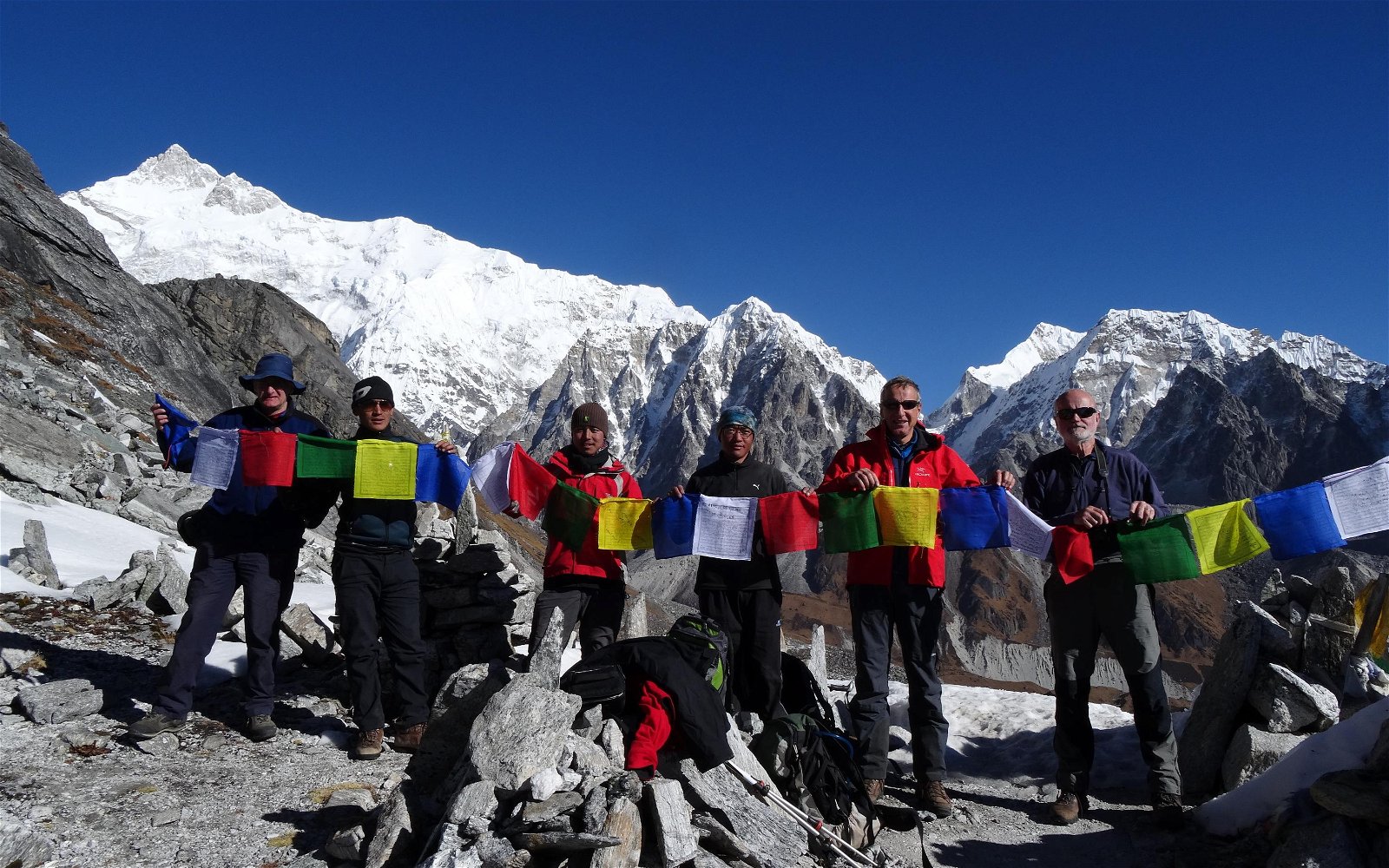
21 days from
A spectacular trek in Sikkim with views of Kangchenjunga from the Singalila Ridge and from below the Goeche La
Holiday Grades
Our holiday grades explained.
To show the relative difficulty of our holidays, each trip is graded on a scale of 1 to 12, with 12 being the most challenging. Although we have tried to make our grading system as clear as possible, it cannot take into account your personal interests, abilities or experience. If you have any questions about the nature of a particular trip or its suitability for you, please read the 'Is this holiday for you?' section or contact us.
1 - 3 LEISURELY
Suitable for most people in good health, holidays at this grade include only limited amounts of activity.
4 - 6 MODERATE
Suitable for reasonably fit individuals, such as weekend walkers and cyclists. There can be the occasional more difficult day.
7 - 9 CHALLENGING
Physically challenging holidays, where you need to be prepared before you go.
10 - 12 TOUGH
Our toughest holidays, involving many long days, often in isolated areas. A high level of fitness and previous wilderness and mountain experience is essential.
- Complete a sensational Indian Himalaya trekking holiday with an itinerary unique to KE
- Experience close up views of Kangchenjunga, the world's third highest peak
- Enjoy pristine wild campsites including at Jumlay Pokhari below the Danphebir Pass
- A fascinating sightseeing day in the British Raj hill-station of Darjeeling
At a Glance
- Group Size 4 to 16
- 14 days trekking
- Max altitude - 4500 metres
- Join In Delhi
Accommodation & Meals
- All meals included
- 7 nights Hotel
- 13 nights Camping
As seen from the characterful hill-station of Darjeeling, the five-summited massif of Kangchenjunga (8586m) dominates the northern horizon. Kangchenjunga is the world's third highest mountain and we make our approach to it by crossing the border into the Indian state and former independent kingdom of Sikkim and trekking up onto the crest of the Singalila Ridge, the prominent spur of high ground that forms the border between India and Nepal. Here, we find views that extend northwards to Kangchenjunga, but also across to the distant Nepalese peaks of Everest and Makalu. Our route continues through a mountain wilderness, taking us via high passes and a succession of lovely camping places to the valley of the Prek Chu. It's from this point, above sacred Samity Lake, that we make our ascent to the viewpoint for Kangchenjunga's huge south-east face. Providing a brilliant travel experience, as well as first-class trekking amongst fabulous mountain scenery, this is a simply superb trekking holiday in the Indian Himalaya.
Is this holiday for you?
This is a unique and exciting trekking holiday, which provides a taste of some of the finest trekking in the generally restricted territory of Sikkim. The conditions we will find on this trek range from easy trails, sometimes in forest, to narrow ridge paths and sometimes rather rougher tracks across glacial moraine and scree. We mostly use well-made and established trails throughout the trek, fol …
This is a unique and exciting trekking holiday, which provides a taste of some of the finest trekking in the generally restricted territory of Sikkim. The conditions we will find on this trek range from easy trails, sometimes in forest, to narrow ridge paths and sometimes rather rougher tracks across glacial moraine and scree. We mostly use well-made and established trails throughout the trek, following the routes used by yak herders, to take their animals to high pastures for grazing in the monsoon months. The unspoiled Himalayan foothills trekking, variety of scenery, the lack of other trekkers and the pristine nature of the campsites make this Sikkim trek special. The pace of a trip such as this has to be governed by speed of our pack animals and porters. Some of the walking days are quite short as a result of this and for this reason we have graded the trip at the lower end of our blue range. However, trekking at altitude is always challenging and there are several longer days during the trek.
Trekking in the Indian state of Sikkim requires a special permit and this is a logistically challenging trip to run. Thirty years of experience in the area mean we know how to get it sorted and the result is one of the finest of all Himalayan treks with a fabulous itinerary unique to KE.
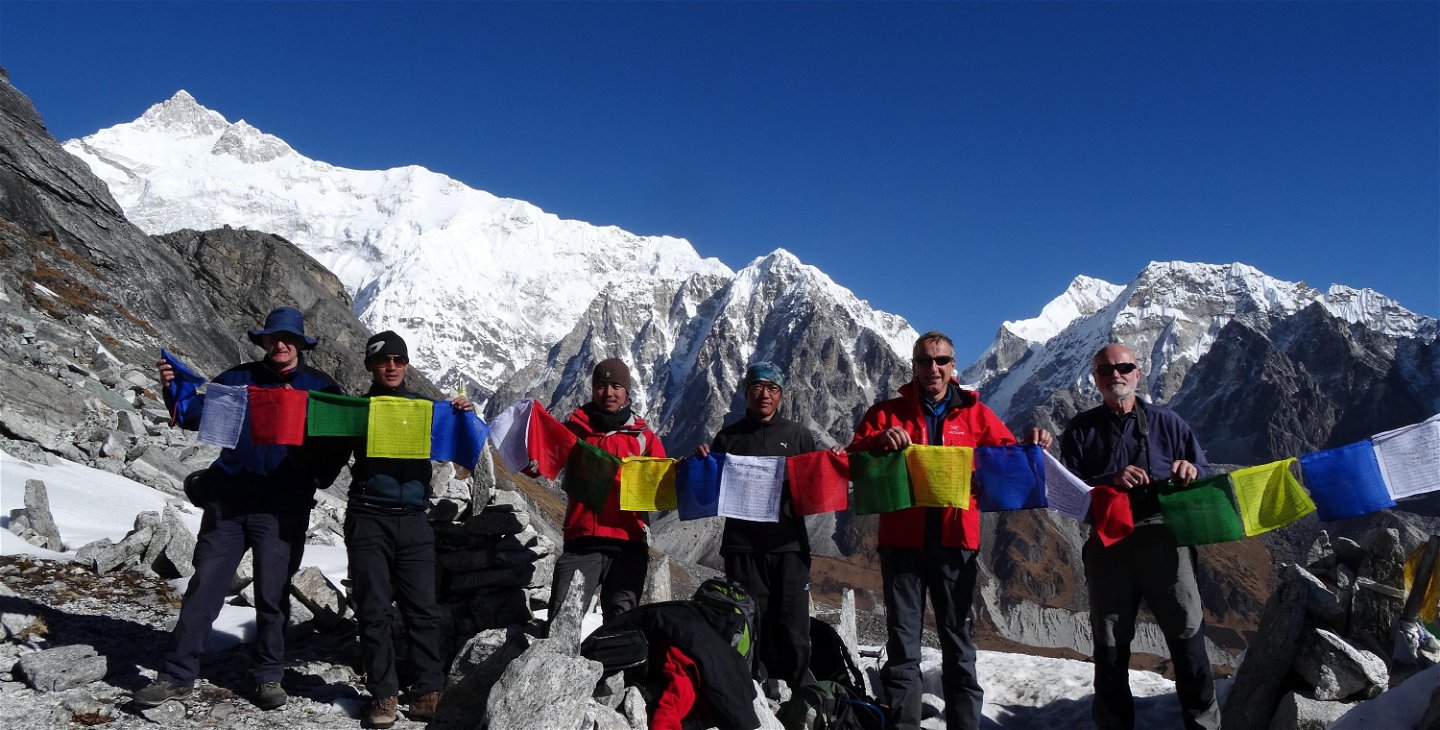
Your holiday starts at the hotel in Delhi. Transfers from Delhi Airport are provided. After lunch there will be a city sightseeing tour. In Old Delhi we visit the Red Fort, built by Emperor Shah Jahan and then walk through the lanes of Chandni Chowk where each lane specializes in a commodity such as spices, jewellery, sequins and book. New Delhi was the creation of the British Raj and is home to many grand buildings designed by the greatest ever British architect, Sir Edwin Lutyens. Alternatively, this afternoon, you may choose to take it easy at the hotel, which is close to the airport.
Accommodation
After breakfast, we drive to the domestic terminal of Delhi Airport. The flight to Bagdogra runs parallel to the Himalayas and if the weather is clear, we have views of all of the Himalayan giants; including Nanda Devi and Panch Chuli, and the 8000 metre peaks; Dhaulagiri, the Annapurnas and Manaslu, Cho Oyu, Everest, Makalu and then the massive bulk of Kangchenjunga, just as we come in to land. Arriving in Bagdogra we are met by our trek leader and we climb aboard the bus for the 4-hour drive to Darjeeling (2500m). At first, we drive through flat rice fields and Assam tea plantations, before the road starts to climb into the foothills of the Himalaya. Darjeeling, built on top of a ridge, faces the Himalaya and is a popular tourist destination for Westerners and Bengalis alike. The richly forested land was originally acquired by the British in 1833, who introduced tea growing and promoted the settlement as a health resort. Arriving in the town, we check in at a comfortable hotel. Just 5 minutes walk from the hotel, there are views northwards to the Himalayan peaks.
After breakfast, we will arrange a sightseeing tour of some of the attractions around Darjeeling. We visit Ghoom Monastery, boasting one of the highest railway stations in the world, as well as a large gilded statue of the Matreya, or future Buddha. We can also visit the Himalayan Mountaineering Institute, which has a superb collection of memorabilia from the early days of Everest exploration. Also on the ‘not to be missed’ list is the Tibetan Refugee Centre where one can purchase handicrafts at reasonable prices. After lunch at our hotel, we can relax in the grounds of the hotel or take a stroll into the nearby and vibrant bazaar streets.
After an early breakfast, we set off by jeep for the 6-8 hour drive through tea estates and lush river valleys to Pelling (2250m). If the road conditions via Tukvar are not good, then we make a detour and drive to Pelling via Melli. Our accommodation is at the delightful family run Pemaling Hotel, which offers superb views of Kanchenjunga from the balcony. Whilst at Pelling, either this afternoon or in the morning, we will take the opportunity to visit Pemayangtse Monastery, Sikkim’s second oldest monastery, which is also the most prestigious centre of religious learning in Western Sikkim.
After breakfast, we take a scenic 3 hour drive through the tea plantations to Uttarey (1960m). The road follows the River Ranjit, passing through a beautiful steep-sided valley en route. At Uttarey, we meet our trekking crew and check our permits at the control post. We then set off on our first afternoon of walking through the scattered Sherpa villages, climbing gradually on a good path through forest to a rest point called Thumki. The trail continues, climbing more steeply to a forest clearing at Uttarpani and then to a viewpoint a Ramite (literally meaning 'something nice') where we can see Kangchenjunga and Pandim. The views get better as we climb further to our camping place on the meadow at Archaley (2880m). Great views of Kangchenjunga and surrounding peaks.
Leaving camp, we descend to a small stream and then ascend through rhododendron forest and via a number of clearings, large and small, with mountain views. It is a pleasant walk on a good trail which leads up to Khardak Danda, another small clearing and a good viewpoint. From here, we continue to climb to some abandoned shepherd huts and then further to our campsite at Kalizar (3450m). The panorama here includes Jannu (7710m), Kangchenjunga and Pandim (6691m). Water is often scarce at this campsite, which means that the kitchen staff have to descend a long way to fill up their jerry-cans.
We get up early to walk up to the viewpoint at Phoktey Dara (3750m), around 45 minutes from camp. There are great views from here of the Nepal Himalaya - Mera Peak, Chamlang, Nuptse, Lhotse (8571m) and Makalu (8481m). On a clear day you can also see distant peaks in Bhutan. Below us we can also look down across steep valley-sides with scattered villages. Descending from our high point, we trek through rich rhododendron and pine forests to Chiwabhanjang where there is a police camp and where we have to show our permits. We then continue through more rhododendron forest, ascending easily to our camp at Major (3270m).
A slightly longer day today, starting out with a steep climb through the rhododendron forest for one and a half hours to a set of prayer flags at a high point of 3500 metres. Although steep, the trail is excellent, having been used for centuries by herders moving their yaks from one grazing ground to another across the ridge. Descending slightly, the path switches between Nepal and Sikkim with spectacular views down either side of the ridge. It is obvious why the trail clings to the ridge top, as there is simply no way down on either side, so dense is the rhododendron forest! In spring, this part of the walk is spectacularly colourful. A level and slightly wider section of the ridge, offers a perfect resting point for lunch, before another small climb and more airy ridge-top trekking leads to our camp just beyond a yak herders camp, known as Dhor (3720m). We camp a little below the ridge-top and have splendid views across a succession of ridges, as well as a autiful sunset panorama of the high peaks of Nepal, including Makalu and Everest.
Just above the camp there is a particularly fine viewpoint for Kangchenjunga and it is worth getting up early to watch the sun rise on the world's 3rd highest mountain. The early morning light along the ridge and the spectacular views of the mountains ahead, make for a great start to the day. We follow the ridge for most of the morning on a good path which once again switches from side to side along the ridge with many short ascents and descents and very little flat walking! The highpoint of the day's trekking is at a collection of prayer flags at 3920 metres, which is reached around mid-morning. After lunch, the trail stays high up, as we continue to our camp at Paharay Megu (3900m) which is one of a series of high grazing areas used during the monsoon.
Leaving our camp at Paharay Megu, we trek by way of a single hut (used as a shelter by pilgrims) and then climb steadily, staying on the west side of the ridge. The terrain becomes more open and the scale of the mountain scenery much grander as we follow a wide valley, turning east, in the direction of a large waterfall and a break in the ridge which takes us to a lunch stop at the pilgrimage site beside the lake of Lam Pokahri which is surrounded by prayer flags and by hundreds of large flat stones that have been turned on their ends by pilgrims as a mark of respect for the gods - an inspiring place. After lunch, we our route skirts the lake and heads towards a quite obvious pass in the distance, marked by 4 cairns. A stweep zig-zag path takes us up to the Kangla (4460m). It is quite atmospheric, walking alongside the yaks and yak men with the sound of jingling yak bells and the whistles from the yak men, urging on their charges. After short celebrations (the next pass is slightly higher) we drop down and then contour across the hillside for a further 30 minutes to reach the Danphebir Pass (4500m) marked by hundreds of prayer flags. The views to the north are once again stunning and we relax for a while to take in the magnificent scenery. Camp is a short distance beyond the pass beside the twin lakes of Jumlay Pokhari (4450m). This excellent campsite offers spectacular sunset and sunrise views and close up views of the mountains.
An early wake-up for the sunrise is an option today. After breakfast, the walk down to the valley floor is most enjoyable, following a good trail across the open slopes at first and then down through pine and juniper forest to Gomothang by the river and then on an undulating trail for an hour or so to a good place for lunch. It's just a short walk after lunch with many ups and downs to Yangseb (3950m) where we camp beside the stream. Depending on the weather conditions, today, we might choose to continue directly to camp for lunch.
Contouring across the hillside, we can now look across to Dzongri, a vast grazing ground on the main trekking route to Kangchenjunga and our destination in 2 days time. We continue contouring across the hillside, climbing at times, until we cross a small river, beyond which a final climb leads to the Kokling Pass( 4260m) adorned by prayer flags and with wonderful views looking back across our route of the last 2 days. A short distance below the pass, the trail climbs steeply once again up the hillside for an hour and then turns a corner to reveal a spectacular view across a wide ridge, to Kabru and Pandim. We now feel that we are getting really close to the big mountains as the landscape opens up in front of us. We camp in a clearing known as Panding (4275m).
We take a direct descent today to the river, the Rathong Chu, which takes a good part of the morning, crossing the stream, we climb easily to a low pass, beyond which we reach the expansive meadows of Chaurikhang (4120m) and then Dzongri (3990m) where we set up camp near a shepherd's hut in a natural bowl on the ridge. The peaks of Pandim, Narsingh and Joponu now appear to be distinctly closer. A short walk above Dzongri is a superb viewpoint for sunset and sunrise on Kangchenjunga, well worth the effort for an early evening stroll. For the best approach to the viewpoint, follow the trail up the ridge, where the viewpoint is easily visible due to the large number of prayer flags. As well as Kangchenjunga, there are superb views of the neighbouring peaks, including Rathong (6683m), Kokthang, Kabru Dome and Forked Peak.
After 9 days of trekking, this is an opportune moment to take a break and Dzongri is a great place to spend a day with the chance to make early and late visits to the prayer flagged viewpoint for the sunrise and sunset views. This day can also be used as a day of contingency in case we have experienced delays earlier in the trek. We spend a second night at the camp at Dzongri.
From Dzongri, we follow the original Kangchenjunga trek to the Goecha La. We are likely to encounter more trekkers from this point on. Today's walk starts with a short climb to a ridge, which affords open views across Sikkim. We follow this scenic ridge for about 5 kilometres, before descending a steep spur to our lunch spot on the banks of the glacial Prek Chu. A short stretch of boulder hopping and then we cross the stream to begin the climb to Thangshing, a large open area of pasture. The southern Ridge of Kangchenjunga and the moraines of the Oglathang Glacier are visible directly ahead and there are close-up views of Pandim. We have lunch at Thangsing and continue for another 2 hours on an easy trail in a wide open valley with Kanchenjunga looming straight ahead. We set up camp at Lamuney (4170m).
After an early start, we follow a path beneath the west side of Pandim, through dwarf azaleas and rhododendron to the first of the terminal moraines of the Oglathang Glacier. We climb to the crest of a moraine ridge and find ourselves on the shores of the lovely and sacred Samity Lake. Ringed by prayer flags and reflecting a number of snow-capped peaks, including Pandim, Samity Lake is a beautiful place. It was formerly possible to camp here, but environmental concerns have led the Sikkimese Authorities to ban this practice. The track to the Goecha La skirts the lake, before ascending a series of moraine ridges on the eastern edge of the Oglathang Glacier to the viewpoint for Kanchenjunga, which we should reach in approximately an hour and a half from the lake. Rising more than 4000 metres above the Talung Glacier, at a distance of only 8 kilometres (5 miles) from our viewpoint, is the stunning eastern wall of Kangchenjunga, which includes the five principal summits of the massif and also the very impressive Kabru and Rathong peaks. Due to conservation efforts to preserve the abode of the snow leopards that inhabit this area, we are not allowed to go further than this viewpoint. Having had our fill of the spectacular panorama, we return to Samity Lake and continue down-valley to Thangsing (3930m), where we camp for the night.
Descending the valley from Thangsing, we take a direct route, missing out Dzongri, following a lower trail through dense rhododendron forest. After a long descent (almost 1500 metres), we set up our camp near the small abandoned Tibetan refugee village of Tsokha. The Sikkim Forest Department have rehabilitated the Tibetan refugees that lived here to other parts of Sikkim. It is a pleasant change to be camping in warmer conditions tonight. From our camp, we look out on ridge after ridge of temperate forest and to the river far below. There is the opportunity for you to try the local millet 'beer' (hereabouts called 'thumba') which is available at the caretaker's hut. This is served in drinking vessels made out of bamboo.
More downhill from our camp, all the way to the Prek Chu. Then the trail follows the narrow Rathong Valley, through thick, semi-tropical forest, contouring the east bank of the river with several undulations and tributary rivers to cross. We are now back in the warmer lower valley and reach Yuksom mid afternoon, where we check in at our hotel. The rest of the day is free and we can take tea in the hotel garden (with distant views of Mount Kabru) and reflect on an excellent trek. Yuksom is an important place in Sikkimese history as the first king of Sikkim was coronated here and his seat can still be seen. You can also a walk up to Dubde Monastery - the first monastery of Sikkim, reached by following a row of prayer flags. In the evening we will have a party to say goodbye to our yak men, porters and Sikkimese trek crew.
After a reasonably early breakfast, we have a 5-hour drive to Kalimpong, which was once an important market town, strategically located at a crossroads between Sikkim, Bhutan, Tibet and the plains of Bengal. One of the principal commercial enterprises of the town today, is the growing of flowers in extensive nurseries. We stay at a comfortable hotel on the outskirts of town and have the chance to explore the bazaar.
After breakfast at our hotel, we drive back to Bagdogra Airport, where we check in for our usually late afternoon flight to Delhi. Arriving in the Indian capital in the early evening, we transfer to our airport accessible hotel. This evening we will have a ‘farewell’ dinner.
Your holiday ends after breakfast. Transfers to Delhi Airport are provided. To extend your holiday in India, why not pre-book a visit to Dharamsala (home of the Dalai Lama), to the Taj Mahal or a longer excursion taking in the whole of India's classic Golden Triangle. Contact our office for details.

Essential Information
We've compiled some of our Frequently Asked Questions to help you learn more about this amazing trip.
- An experienced English-speaking leader
- Delhi Airport transfers on group arrival and departure days
- All internal flights and land transport involved in the itinerary
- All accommodation as described in the trip dossier
- All meals throughout the trip
- Full trekking service including food and all equipment (excluding personal equipment)
- Travel insurance
- Delhi Airport transfers (other than on group arrival and departure days)
- Indian Visa
- Tips for trek staff
- Miscellaneous expenses - drinks and souvenirs etc.
The group will meet at the hotel in Delhi. Transfers are provided from/to Delhi Airport for all clients arriving on Day 1 of the Land Only itinerary and departing on the last day of the Land Only itinerary. Hotel contact details and an emergency number will be provided with your booking confirmation.
All meals are included
It is not recommended to drink untreated water from the taps. If you are on a trekking or cycling holiday, water is supplied to fill up your individual bottles. This will be boiled, filtered or provided in large jerry cans or 5 litre bottles. Additionally you should take purification tablets or a filter bottle (such as a Water-To-Go bottle ) to treat your water when in towns or where water is not supplied. We do not encourage the purchasing of single use plastic bottles.
The food served during the trek is a mixture of local and Western, mostly purchased locally and cooked for us by highly trained trek cooks. The emphasis is on providing a high-carbohydrate and largely vegetarian diet, which we have found to be easily digestible at high altitude. In Delhi, we take our meals in the group hotel or in nearby restaurants. All meals while on trek and while staying in hotels are included in the trip price.
Whilst we can cater for vegetarians, albeit sometimes with a more limited choice, we cannot always provide special diets. Due to the nature of some of the trips that we operate and the countries in which we operate them, it can be very hard (and sometimes impossible) to cater for a wide range of dietary choices and you may have to supplement your diet with food/snacks from home. If you have specific dietary requirements please do speak to our sales team and they will be able to advise you whether or not we will be able to offer your specific choice. Please note that we are unable to provide separate menus and cannot accept liability for any problems arising from special dietary requirements or intolerances.
On arrival in Delhi and for one night after the trek, we stay at a hotel close to the airport which provides comfortable accommodation, as well as pleasant gardens and a pool. Being near the airport makes the whole travel experience more relaxing, whilst still allowing us to include a sightseeing city tour. Our itinerary also includes 2 nights in a comfortable hotel in Darjeeling, 1 night in a hotel in Yoksom and 1 night in a hotel in Kalimpong. On trek there will be 13 nights camping. All accommodation is allocated on a twin-sharing basis. If you are travelling by yourself, you will be paired up with another single client of the same sex. It is possible to hire a single tent while on trek. Depending upon availability it may be possible to arrange single rooms For Hotel prices and single supplement costs please refer to the dates and prices page of the trip on our website.
The group will be led by an experienced English-speaking trek leader who will meet the group in Bagdogra. While in Delhi the group will be looked after by a KE representative. During the trek, the trip leader will be assisted by local guides, camp staff including a cook and by baggage ponymen.
This holiday involves going to very high altitude. During the course of your trip you will be spending at least one night above 4000 metres and/or trekking to 5000 metres or above. This is not something that you should worry about; the human body is quite capable of adapting to a very wide range of altitudes, but it is important that we follow some simple rules in order to acclimatise successfully. Before coming on this holiday you should read the advice on trekking at high altitude . Unless you have previous experience of trekking above 4000 metres you should consult one of our trekking experts before embarking on this holiday. On this trip we carry a portable altitude chamber (PAC-bag) and/or bottled oxygen for use in emergencies.
Approximately £200 (or equivalent in Euros / US dollars etc.) changed into local currency, should be allowed for miscellaneous expenses, including porter and trek crew tips and soft drinks, etc. It is not necessary to purchase local currency (Indian Rupees) before you travel. We recommend taking your personal spending money in cash since you will be changing the majority of this into local currency on the day of arrival. Sterling, US dollars and Euros are readily exchanged in Delhi. Credit cards can be used to purchase many goods in Delhi and are particularly useful for more expensive souvenirs. It is also possible to withdraw cash (rupees only) from cash machines in Delhi using credit and debit cards.
Tips are the accepted way of saying ‘thank you’ to your local guides and porters. Tips do not form part of their wages. KE always pays local crews the best rates of pay, no matter what country they are in and any tips they receive are seen as a personal thank you from group members. For our part, we advise local teams that tips are not a duty or a prerequisite but are a bonus and entirely dependent on the service that was given. Most people will want to tips their guides and support staff and we recommend that you do this as a group. As a guide, we suggest that a contribution of approximately £70 (in Indian rupees) from each group member will provide a sufficient pool for these tips. At the end of a trek many people also like to donate various items of their equipment to the porters and trek staff who work so hard to make the trip a success. Boots, gloves, hats, scarves and even socks (clean of course) are always warmly received by the porters and ponymen, many of whom are simple farmers earning extra cash by porterring for trekking groups. Technical clothing and equipment such as head-torches and trekking poles are highly prized by the local guides and camp crews.
For this holiday you should take one piece of luggage, which should be a soft and sturdy duffel bag, and a day pack. Your baggage on trek will be carried by porters or pack animals and should weigh no more than 15kg. Please note that the check-in baggage limit on all internal flights within India is now 15kg and you are responsible for any excess baggage charges that the airline may apply. It is possible to leave travel clothes and any other items not required on trek at the group hotel.
For each holiday there is a minimum number of participants required to enable it to go ahead. Once the minimum number is reached, the trip status will change from 'Available' to 'Guaranteed to run'. You can check the trip status for each departure in ‘Dates and Prices’ table. Other than in exceptional circumstances, we will not cancel a trip once it has achieved this guaranteed to run status and so you are free to proceed with your international flight booking and other travel arrangements.
The information that we provide is for UK passport holders. A passport with 6 months remaining validity at the end of your stay is generally required , and you should have at least 2 blank pages for each country that you visit.
It is your responsibility to ensure that you have the correct travel documents and visas for your holiday. Please ensure that you check for the latest advice before travel. For the most up to date information on entry requirements, please visit the UK Government website .
Most nationalities, including travellers from the UK, the USA and many European countries can apply for their Indian Visa online through the E-Visa Application process. You must make your application at least four days prior to departure. Please download the detailed information document for details of how to apply for your visa: Visa India PDF
If you have a severe allergy please inform the KE office before you travel. We will do all we can to help, but we cannot guarantee an allergy free environment on KE trips. You will need to carry your own treatment for the allergy with you, as 'adrenaline auto-injectors' are not carried as standard by KE leaders and staff. You should inform your leader on arrival of your allergy, and let them know where you keep your adrenaline pen.
Dengue fever is a known risk in places visited. It is a tropical viral disease spread by daytime biting mosquitoes. There is currently no vaccine or prophylaxis available and therefore the best form of prevention is to avoid being bitten. We recommend you take precautions to avoid mosquito bites .
Zika virus has been confirmed as active in this country. It is a tropical viral disease spread by daytime biting mosquitoes. There is currently no vaccine or prophylaxis available and therefore the best form of prevention is to avoid being bitten. We recommend you take the usual precautions to avoid mosquito bites. The mosquitoes that transmit ZIKV are unlikely to be found above 2,000m altitude. For more information, visit the website of the National Travel Network and Centre (NaTHNaC) at https://travelhealthpro.org.uk
Vaccinations
You should contact your doctor or travel clinic to check whether you require any specific vaccinations or other preventive measures. You should be up to date with routine courses and boosters as recommended in the UK e.g. diphtheria-tetanus-polio and measles-mumps-rubella, along with hepatitis A and typhoid.
Malarial prophylaxis is not usually required for trips in the mountains, however if you are visiting rural and remote low lying areas then they might be necessary.
On holidays to more remote areas you should also have a dentist check up. A good online resource is Travel Health Pro .
The currency of India is the Indian Rupee.
It makes a lot of sense to spend some time before coming on a trekking trip getting some additional exercise. The fitter you are, after all, the more enjoyable you will find the experience. For this trip you need to be aerobically fit and also comfortable with walking up to 7 hours each day and longer on some days. We would suggest that you adopt a weekly exercise regime leading up to your trip. Regular hiking in hill country is the best training but any regular excercise will be good for developing cardio vascular fitness and stamina. Before departure, we suggest that you try to fit in a number of long walks in hilly country.
During both the spring and autumn departures, the daytime temperatures will be of the order of 25°C at Darjeeling and will be rather cooler, at about 10°C to 15°C once on trek. Night time temperatures at our highest camps will certainly drop below freezing and you must be prepared for cold, often damp, evenings at camp. Our trek dates are outside the monsoon period but you should be aware that the eastern end of the Himalaya receives more rainfall than further west in the Everest or Annapurna regions. It can and does rain here and you should be prepared for this. Generally, the period outside of the monsoon is stable, but weather in the Himalayan foothills is notoriously difficult to predict and short-lived storms can occur at any time of the year.
As a reputable tour operator, KE supports the British Foreign, Commonwealth and Development Office's ‘Travel Aware ’ campaign to enable British citizens to prepare for their journeys overseas. The 'Travel Aware' website provides a single, authoritative source of advice for all kinds of travellers and we recommend that prior to travel, all KE clients visit the official UK Government website at travelaware.campaign.gov.uk and read the FCDO Travel Advice for their chosen destination. North Americans can also check out the U.S. Department of State website: www.travel.state.gov for essential travel advice and tips.
KE treat the safety and security of all clients as the most important aspect of any trip we organise. We would not run any trip that we did not consider reasonably safe. Should the FCDO advise against travel for any reason, we will contact everyone booked to travel to discuss the situation. We receive regular updates direct from the FCDO and are in constant touch with our contacts on the ground. If you have any questions about government travel advice, please call our office.
KE do not encourage the use of single use plastic items. We are ensuring that our agents all over the world are working together to reduce the problem and educate those around them. We are leading by example in our KE office by reducing our plastic use.
Top Treks of the World. New Holland /Steve Razzetti
Trekking in the Indian Himalaya. Lonely Planet
India. A Travel Survival Kit. Lonely Planet
The Trekkers Guide to Pakistan and India. Hugh Swift
Exploring the Hidden Himalaya. Kapadia and Mehta
Sikkim Himalaya – 1: 150,000. Schweizerische Stiftung für Alpine Forschung (Swiss Foundation For Alpine Research)
Although a monochrome map (black and white detail with a sepia coloured relief shading), this map is much more detailed than some other more colourful maps. As well as the relief shading it has 100 metre contours, spot heights, peaks, passes, and glaciers, and graphics to show various types of terrain. Coverage extends south to Darjeeling, and within Nepal to the western edge of the Kanchenjunga Glacier.
It is an essential condition of joining a holiday with KE Adventure Travel that you have a valid travel insurance policy to cover the cost of medical treatment and to protect the value of your holiday in the event of cancellation. When taking out insurance please ensure the policy you choose covers you for the activities and altitude included in your itinerary.
For appropriate insurance cover we recommend Campbell Irvine Direct. Please go to our Travel Insurance page for further information and to get a quote.
The following checklist should help you with your packing. As a general rule, you should always try to keep the weight of your equipment to a minimum. The packed weight of your bag whilst trekking should be no more than 15 kgs.
You must bring the following items:
Hiking boots
Trainers or sandals for river crossings and camp use
Walking socks (2 or 3 pairs)
Trekking trousers
Waterproof overtrousers
Thermal baselayer - leggings
Baselayer shirts
Shirts or T-shirts
Fleece jacket or warm jumper
Waterproof jacket
Warm jacket (down)
Headtorch and spare batteries
Daypack 30 to 40 litres
Water bottles 1 litre (x2) (we encourage re-filling water bottles rather than single use plastic)
- Water purification tablets
Warmer and waterproof gloves or mittens
Sleeping bag (comfort rated -20ºC)*
Washbag and toiletries
Small towel
Antibacterial handwash
Basic First Aid Kit including: antiseptic cream, throat lozenges, diarrhoea treatment (Imodium), altitude (Diamox), painkillers, plasters and blister treatment, and re-hydration salts (Dioralite).
Sun protection (including total bloc for lips, nose etc.)
The following items are optional:
Thermarest (note that foam mattresses are provided)
Trekking poles (recommended)
Insect repellant
Spare laces
Scarf or buff
Sleeping bag liner
Travel clothes
Pen-knife (note: always pack sharp objects in hold baggage)
Repair kit – (eg. needle, thread, duct tape)
- Reusable cloth bag for shopping (to avoid plastic bags)
Equipment hire / rental
Items marked * can be hired / rented through KE Adventure Travel. Please make requests at least 6 weeks prior to the trip departure.
Note all hire / rental equipment will be issued in Delhi.
Specialist Equipment
Depending on the conditions, the trip leader may issue ‘in-step’ crampons to group members for the crossing of the Goeche La. These are small lightweight crampons which can quickly and easily be attached to any kind of walking boot. We would strongly recommend that you bring a pair of trekking poles for the pass crossings.
Agra and Jaipur four day extension
The Golden Triangle needs little introduction and is rightly considered a classic trip in its own right. Easily accessible from Delhi, this excursion takes in the wonders of the magestic Agra Fort,...
US$735 per person
Extension Details
The Golden Triangle needs little introduction and is rightly considered a classic trip in its own right. Easily accessible from Delhi, this excursion takes in the wonders of the magestic Agra Fort, the incomparable Taj Mahal, the abandoned ghost-city of Fatehpur Sikri and the architectural jewels of Jaipur and Amber. This four day trip ensures you get the most out of these stunning attractions at a relaxed and unhurried pace.
Sharing Price from
Single traveller price from, single room supplement from, deposit per person from.
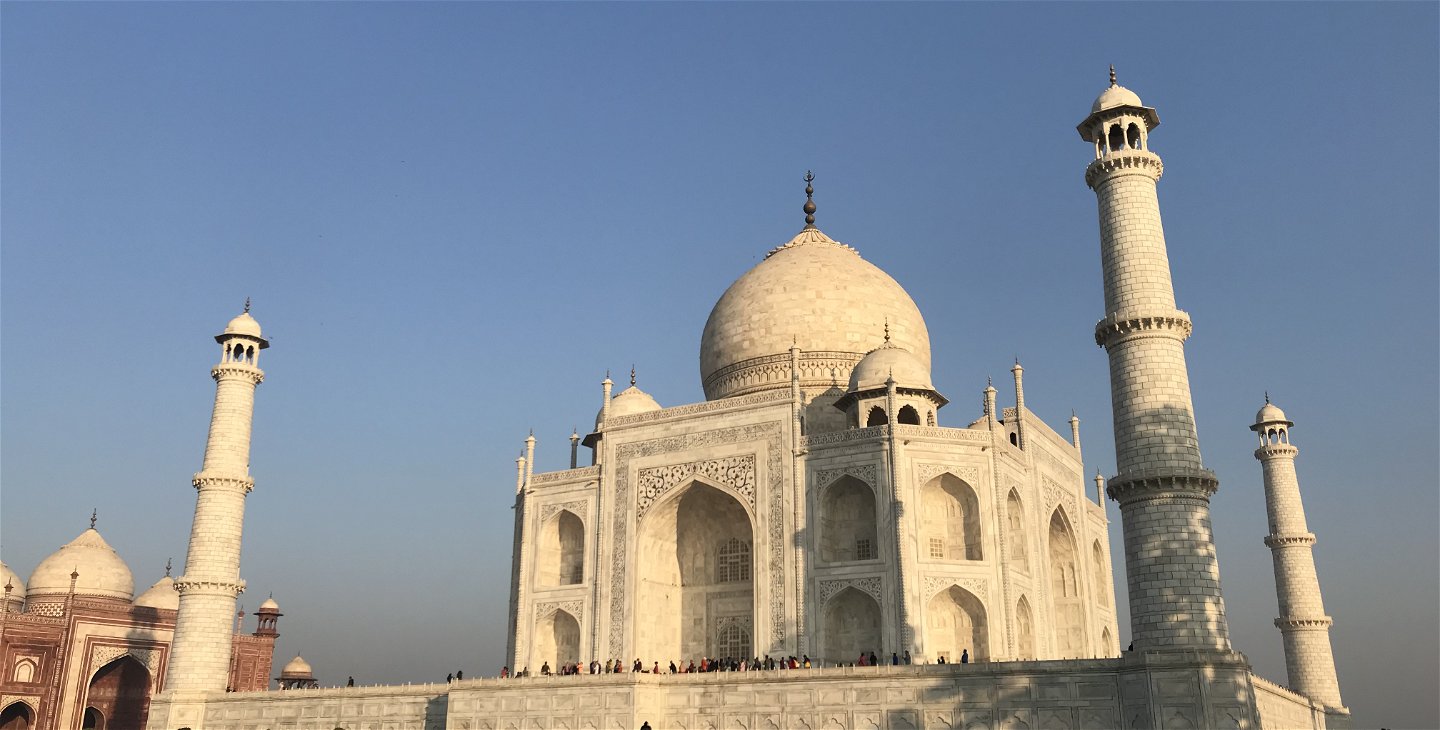
Extension Itinerary
KE extension package services begin with a pick-up at the hotel at 0930 hrs. Your private vehicle will transfer you to Agra. Upon arrival you will have an opportunity to check in to your hotel and settle in. In the afternoon, you will have a guided tour of the magnificent Agra Fort. This red sandstone and white marble fort houses a number of palaces, steeped in lore and history. See the cell where Emperor Shah Jahan was interred, with its desperately sad view towards the Taj Mahal, resting place of his beloved wife. Note: The Archaeological Survey of India (ASI) are responsible for the conservation of many monuments in India (including the Taj Mahal). This organisation will occasionally undertake work to restore the various monuments, but often without notice, so it is difficult to forewarn our customers of this work. It is possible that, at any time, monuments on this trip could be having work done on them.
You will be taken before the break of dawn to the Taj Mahal. Seeing the first rays of sunlight hit the ethereally sublimeTaj Mahal is an experierence that will stay with you for ever. You will have time to wander through the beautiful gardens and buildings that surround the mausoleum complex. After our guided tour we carry on explore the ghost city of Fatehpur Sikri, former seat of the Mughal Empire, before continuing to Jaipur, the capital of Rajisthan.
Today you will have a full day of sight-seeing. You will visit the Hawa Mahal, otherwise known as the Palace of the Wind and the City Palace, full of incredible artifacts. Later you will drive out of Jaipur to visit the Amber Fort, perched high in the hills. The palace here is full of stunning rooms, including the Hall of Mirrors. After taking in the incredible views across the hills, you return to Jaipur.
After breakfast you will be set off in your private vehicle to Delhi, and delivered to either your hotel or the airport for your departure.
Whats Included
- Hotels in Agra and Jaipur
- Breakfast on each day
- Monument entrance fees
- English speaking guide at each monument
- Transport by air-conditioned vehicle
What's Not Included
- dinners and drinks
- Tips for your guide and driver
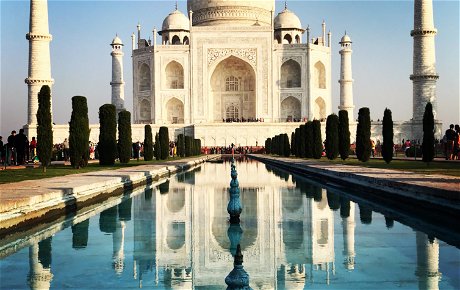
One day tour of Agra and the Taj Mahal
The Taj Mahal needs little introduction. Built by the Moghul emperor Shah Jahan as a mausoleum for his beloved wife Mumtaz, it is widely considered to be the most beautiful building in the world. N...
US$290 per person
The Taj Mahal needs little introduction. Built by the Moghul emperor Shah Jahan as a mausoleum for his beloved wife Mumtaz, it is widely considered to be the most beautiful building in the world. Nearby is the oft overlooked Agra Fort, itself an awe-inspiring and magnificent complex of palaces and ancient forts. Traveling from Delhi on the express train and returning by private vehicle, our one-day extension to Agra is perfect for those with limited time who wish to complete their India experience with exploring one of the most admired and loved buildings on the planet.
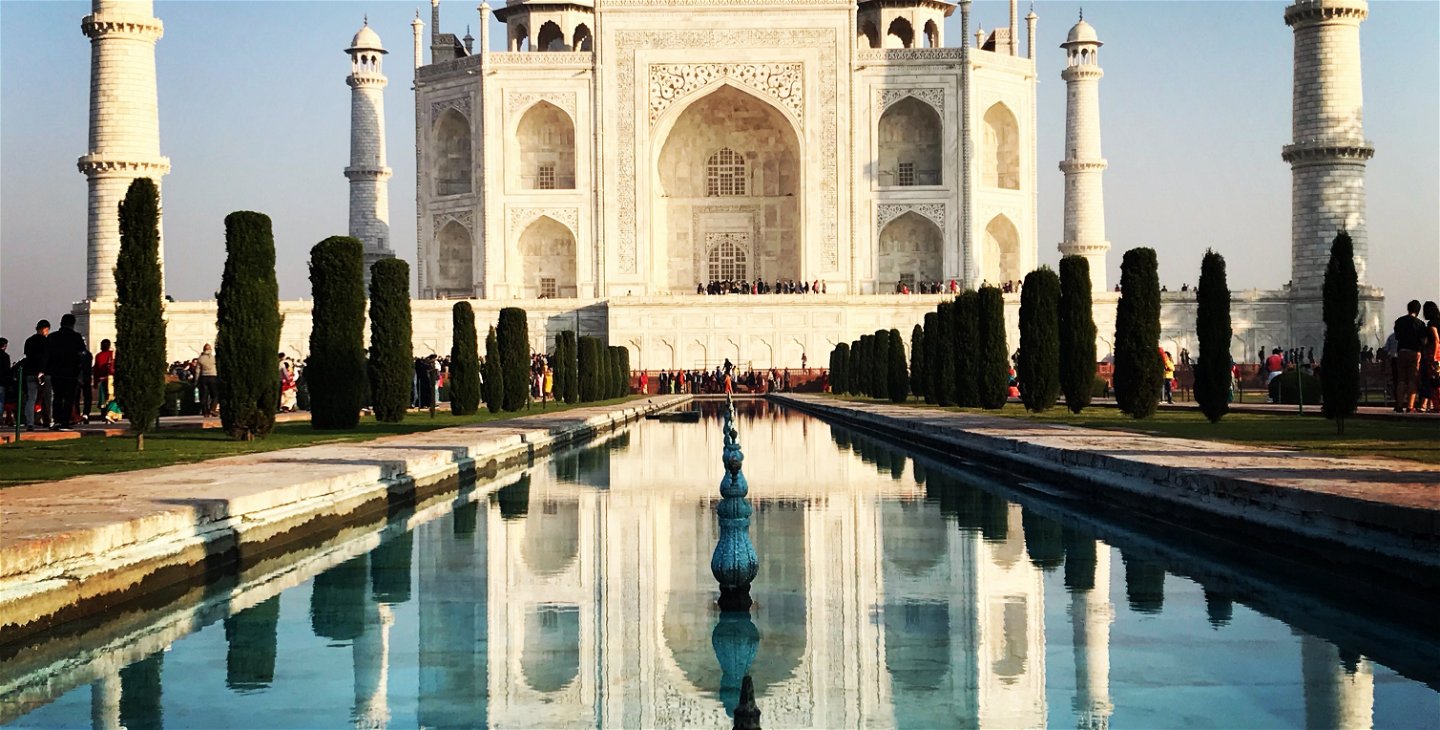
KE extension package services begin with a pick up at the hotel. You will then depart from Delhi on the early morning express train to Agra. Upon arrival, you will have a guided tour of the magnificent Agra Fort. This red sandstone and white marble fort houses a number of palaces, steeped in lore and history. You can visit the ornate cell where Emperor Shah Jahan was interred, with its desperately sad view towards the Taj Mahal; resting place of his beloved wife. Afterwards, you will visit the ethereally sublime Taj Mahal, an experience that will stay with you forever. You will have time to wander through the beautiful gardens and buildings that surround the mausoleum complex. After this incredible tour you will then be transferred by a private vehicle back to Delhi, to either your hotel or directly to the airport where services end. Note: The Archaeological Survey of India (ASI) are responsible for the conservation of many monuments in India (including the Taj Mahal). This organisation will occasionally undertake work to restore the various monuments, but often without notice, so it is difficult to forewarn our customers of this work. It is possible that, at any time, monuments on this trip could be having work done on them.
- Professional local guide at the Taj Mahal and Agra Fort
- Monument entrance fees to Taj Mahal and Agra Fort
- Express train from Delhi to Agra
- Private vehicle transport in Agra
- Private vehicle transfer from Agra to Delhi
- Transfers from Delhi hotel to railway station
- Indian visa if joining from another country
- Any additional transfers
- Tips for your guides and drivers
- Accommodation in Delhi
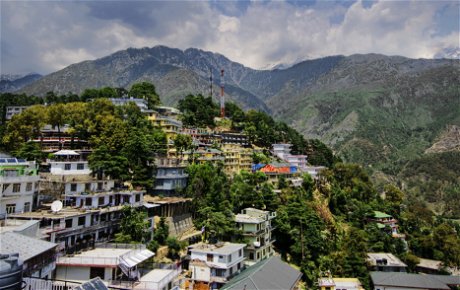
Dharamsala and the Dalai Lama
Dharamsala is a former British Raj hill-station in the Dhaula Dhar mountain range and currently home to the Dalai Lama and the Tibetan Government in exile. On this four day extension, you will be able...
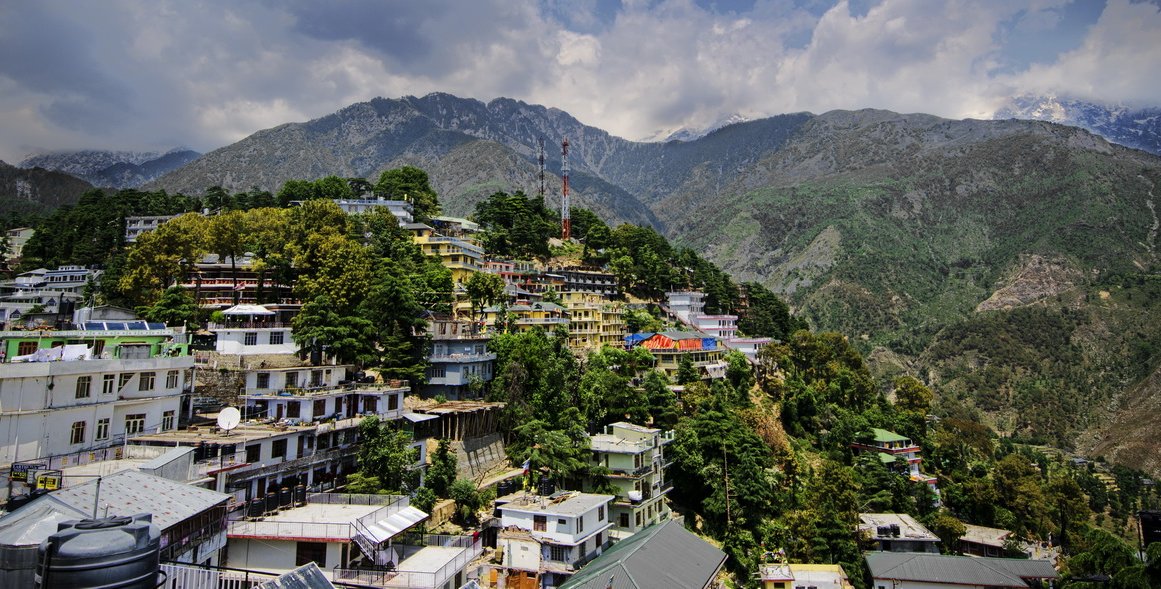
Fly to Dharamsala Airport and transfer (14 kms - 20 minutes) to Dharamsala, an early nineteenth century British Raj hill station, now famous for being the home of the Tibetan Government in exile and home to the Dalai Lama. We check in at our hotel in upper Dharamsala, the village known as McLeodganj which exhibits a strong Tibetan influence with monasteries, Tibetan restaurants and shops. Free time.
Today we visit the Dalai Lama's temple to see some of the Tibetan monks performing a puja. After lunch we will visit the nearby Tibetan Children's Village which houses orphans and ensures they are provided with an education, clothes, food and healthcare. Later we will visit the Norbulingka Institute, a registered trust chaired by the Dalai Lama dedicated to the preservation of Tibetan culture.
Transfer to the Gaddi village of Naddi (1900m) offering views of the Dhauladhar mountain range. Visit a local house and walk to the Buddhist stupa and Tibetan monks meditation huts. Take lunch on low Tibetan tables with sensational mountain views. Short walk to Bagsu Nag village for chai in a local restaurant before returning to our hotel.
After breakfast, you will be taken back to Dharamsala Airport to catch your return flight to Delhi. Services end on arrival in Delhi.
- Transfer to Delhi Airport on Day 1
- Internal flights Delhi to Dharamsala return
- Dharamsala Airport transfers
- 3 nights accommodation in Dharamsala
- Guided sightseeing on Days 2 and 3
- Entrance fees at temples etc
- All meals from lunch on Day 1 to breakfast on Day 4
- Miscellaneous personal expenses such as souvenirs and soft drinks
- Tips for local staff
- FAMILY / GROUP PRICES: Please contact KE for prices
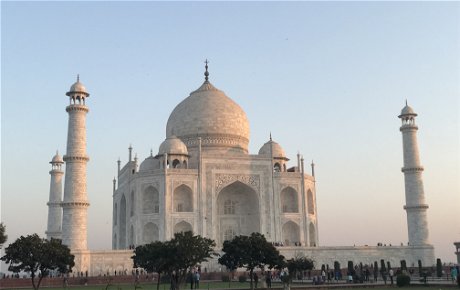
Agra & the Taj Mahal two day tour
Our two-day extension is for those who wish to explore Agra and the surrounding area at a relaxed pace. We start by exploring the oft overlooked Agra Fort, itself an awe-inspiring and magnifi...
US$470 per person
Our two-day extension is for those who wish to explore Agra and the surrounding area at a relaxed pace. We start by exploring the oft overlooked Agra Fort, itself an awe-inspiring and magnificent complex of palaces and ancient forts, before waking before the next day to see the sunrise break over the Taj Mahal. Needing little introduction, the Taj Mahal was built by the Moghul emperor Shah Jahan as a mausoleum for his beloved wife Mumtaz. It is widely considered to be the most beautiful building in the world. This tour also gives us an opportunity to explore the fascinating abandoned ghost city of Fatehpur Sikri.
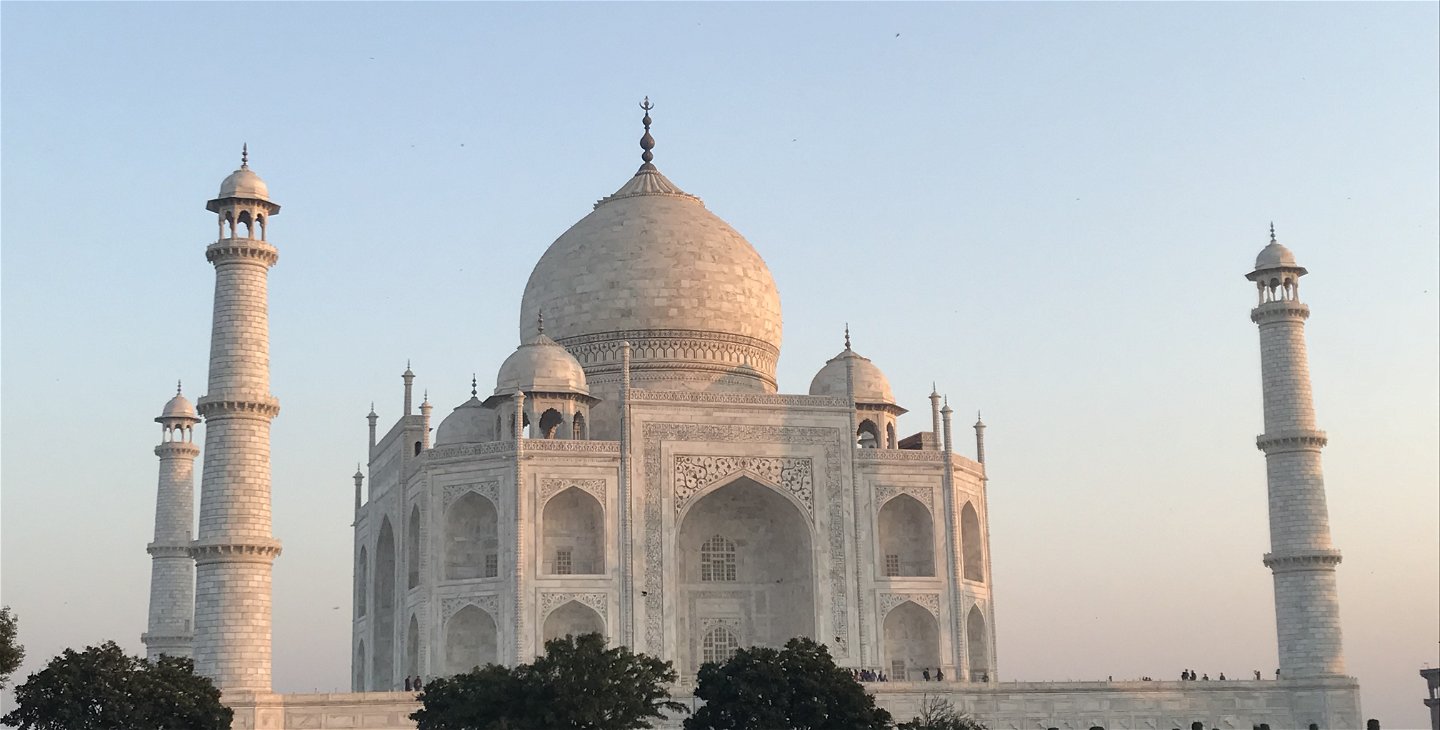
KE extension package services begin with a pick up at the hotel. We then depart from Delhi on the early morning express train to Agra. Upon arrival you will have an opportunity to check in to your hotel and settle in. In the afternoon, you will have a guided tour of the magnificent Agra Fort. This red sandstone and white marble fort houses a number of palaces, steeped in lore and history. See the cell where Emperor Shah Jahan was interred, with its desperately sad view towards the Taj Mahal; resting place of his beloved wife.
You will be taken, before the break of dawn, to the Taj Mahal. Seeing the first rays of sunlight hit the ethereally sublime Taj Mahal is an experience that will stay with you forever. You will have time to wander through the beautiful gardens and buildings that surround the mausoleum complex. After our guided tour, we carry on explore the abandoned ghost city of Fatehpur Sikri, before driving back to Delhi to either your hotel or directly to the airport where services end. Note: The Archaeological Survey of India (ASI) are responsible for the conservation of many monuments in India (including the Taj Mahal). This organisation will occasionally undertake work to restore the various monuments, but often without notice, so it is difficult to forewarn our customers of this work. It is possible that, at any time, monuments on this trip could be having work done on them.
- Professional local guide in Agra
- 1 night at Agra hotel on bed and breakfast basis
- Transfers once at the Taj Mahal and Agra.
- Meals other than breakfast
- Miscellaneous expenses - drinks and souvenirs etc
- NOTE: THE TAJ MAHAL IS CLOSED ON FRIDAYS
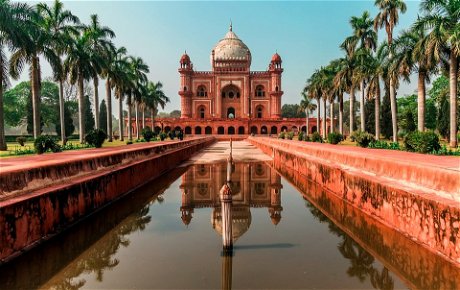
Delhi Sightseeing Tour - Full day
Old Delhi is centred on the Red Fort and is a labyrinth of narrow, bustling streets including Chandni Chowk bazaar. Must-sees here include the Red Fort, built by Emperor Shah Jahan; Hummayan's Tomb...
US$170 per person
Old Delhi is centred on the Red Fort and is a labyrinth of narrow, bustling streets including Chandni Chowk bazaar. Must-sees here include the Red Fort, built by Emperor Shah Jahan; Hummayan's Tomb, constructed in similar style to the Taj Mahal and the towering Qutab Minar minaret. New Delhi was the creation of the British Raj who wanted to show their ascendency over the former Mogul rulers with many grand buildings designed by the greatest ever British architect, Sir Edwin Lutyens. Exploring this area by vehicle will give a glimpse of this interesting aspect of India.
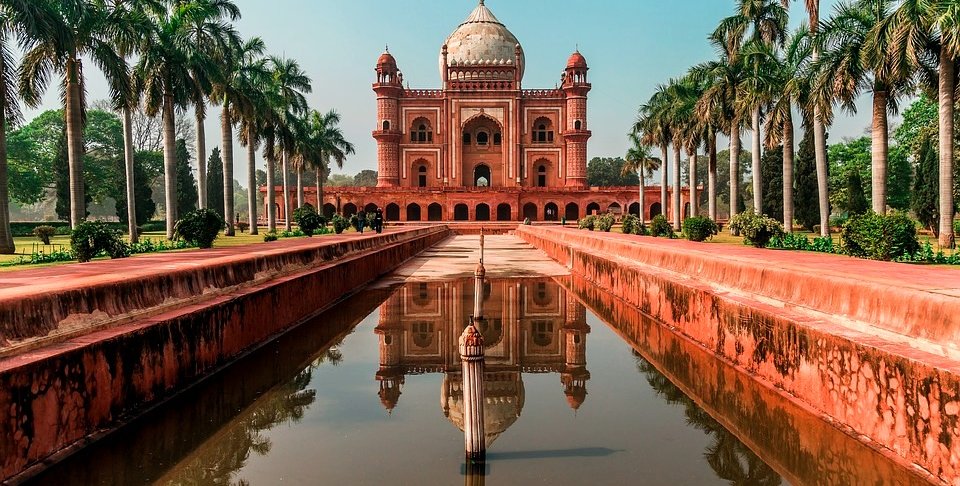
Delhi has seen the rise and fall of many empires and each dynasty has left behind monuments and memories to commemorate the grandeur of bygone days. Very few cities in the world offer such diversity in architectural styles, successfully combining the ancient with modernity. KE extension package services begin with a pick up by private car and driver from the hotel at 0930. The city tour includes a visit to the Red Fort; the majestic Jama Masjid, the Humayun Tomb and the Qutab Minar, with a drive past the Lutyens buildings. The tour ends with a drop-off back at the hotel at around 1800.
- Professional local guide
- Private driver and vehicle in Delhi
- Entrance fees to monuments (must be paid directly in local currency) - allow a total of approximately 900 Indian rupees
- Meals and drinks
A holiday of a lifetime experience ★★★★★
An outstanding trek in breathtaking scenery ★★★★★
A beautiful trek up close to Kangchenjunga ★★★★★
This is a beautiful trek with splendid views of Kangchenjunga and surrounding mountains, and wonderful forests. It was very peaceful, especially in the earlier stages. Rimo's organisation was first class, the crew were very good, the food delicious (sooo many cakes!), and Uden's leadership was outstanding.
Wonderfully unspoilt trekking ★★★★★
Beautiful, challenging and very remote trekking Kanchenjunga National Park ★★★★★
Traveller Reviews
A holiday of a lifetime experience, an outstanding trek in breathtaking scenery, a beautiful trek up close to kangchenjunga, wonderfully unspoilt trekking, beautiful, challenging and very remote trekking kanchenjunga national park, related articles.
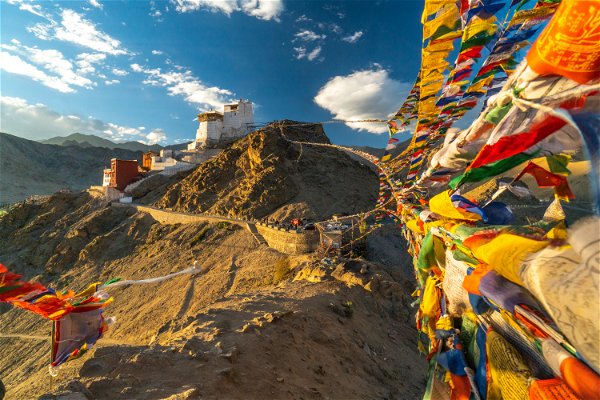
Another view of the Himalaya
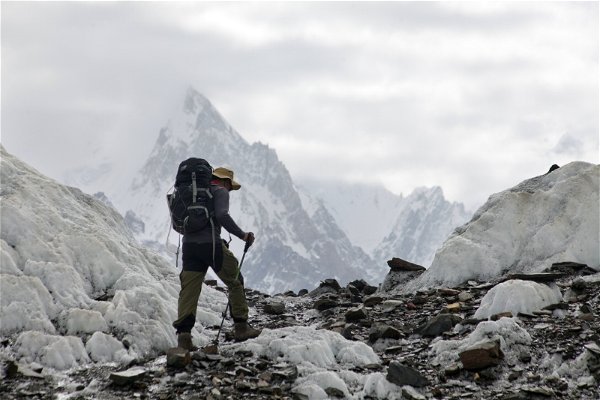
Classic camping holidays in the Himalaya
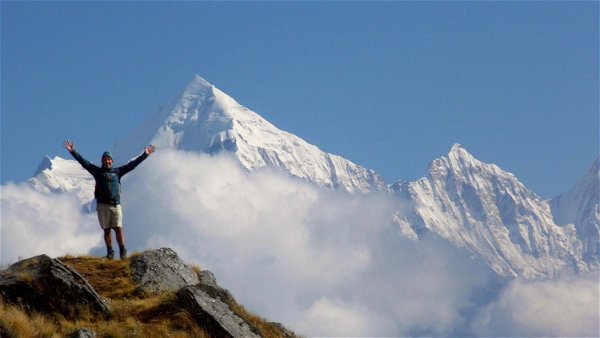
Kit's guide to the Himalaya and Karakoram
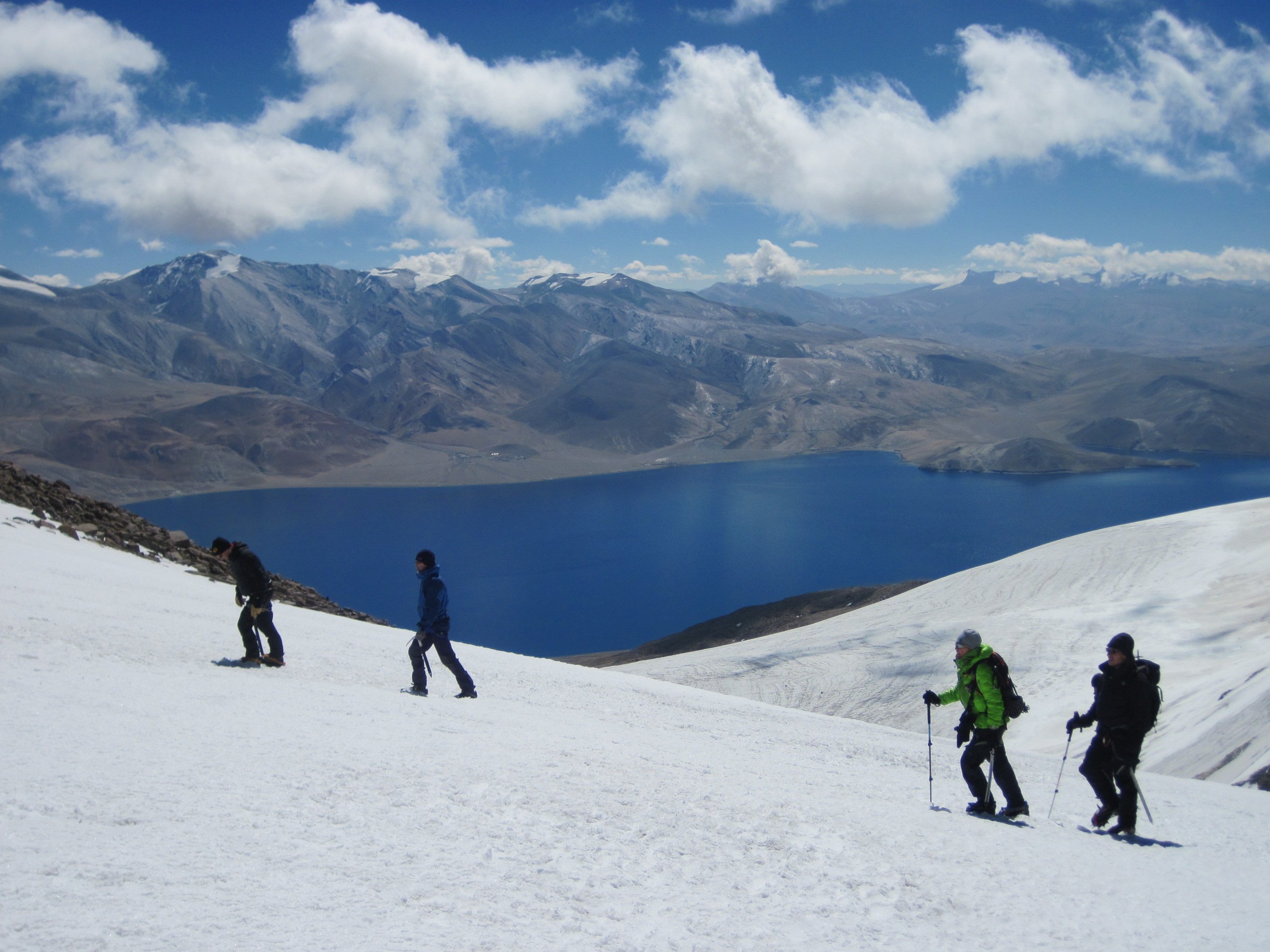
Six 6,000m peak challenges
Other Trips You Might like
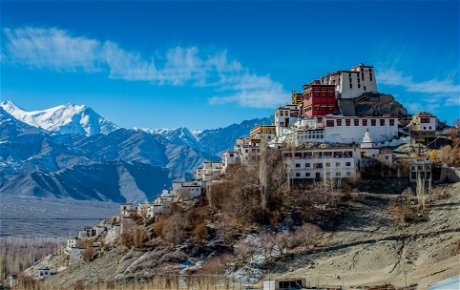
Peaks and Passes of the Nubra Valley
India , Ladakh
Remote trekking holiday in northern Ladakh including ascents of Samgyal Peak (5814m) and Dawa Peak (5900m)
18 days from
US$2,995 without flights
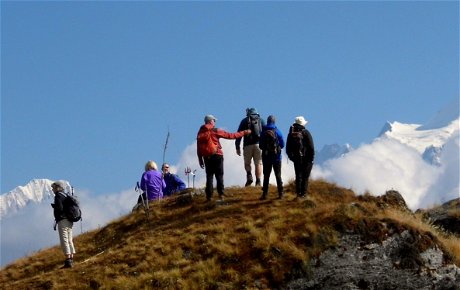
In the Shadow of Nanda Devi
India , Indian Himalaya
Trek through an unspoiled region of the Himalayas across pristine alpine meadows and mountain passes
14 days from
US$2,455 without flights
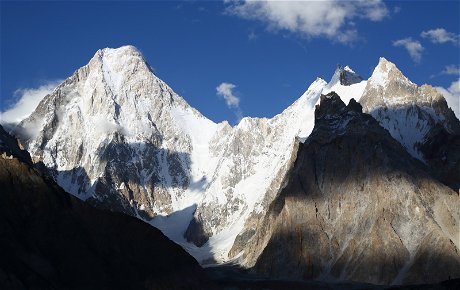
K2 and Concordia
Pakistan , Karakoram
A trekking holiday to K2 and Concordia in the Karakoram Mountains of Pakistan
20 days from
US$3,805 without flights
DATES & PRICES
Private Departure?
Gather a few friends, family or club and take over your own departure.
Adults from
More Information
- Sikkim - Beneath Kangchenjunga Trek With Flights Without Flights
- Departure Reference: SIK /02/24/
- This trip departs the UK on Sat 26 Oct returning to the UK on Sat 16 Nov This trip begins on Sun 27 Oct and ends on Sat 16 Nov
- This departure is guaranteed. Secure your place today with a deposit of US$900
- Single Supplement Price: US$530 - Includes all group hotel and lodge nights.
- Single Tent Upgrade: US$175
Download Trip Notes
- Departure Reference: SIK /01/25/
- This trip departs the UK on Sat 4 Oct returning to the UK on Sat 25 Oct This trip begins on Sun 5 Oct and ends on Sat 25 Oct
- This departure is available to book. Secure your place today with a deposit of US$900
- Departure Reference: SIK /02/25/
- This trip departs the UK on Sat 25 Oct returning to the UK on Sat 15 Nov This trip begins on Sun 26 Oct and ends on Sat 15 Nov
Land Only Information
ZEN_HOLIDAY_DATES_PRICES_LAND_ONLY_USD_NOTICE
Flight Inclusive Information
Changes to flights.
Please be aware that the flight industry is experiencing a high level of service fluctuation and changes to your flights may occur. This may also require amends to the transfers and joining arrangements. Thank you all for continuing your patience and understanding.
BOOK WITH KE CONFIDENCE - No surcharge guarantee
The price of our holidays can change depending on a variety of factors but unlike some other tour operators, KE have undertaken to guarantee the Land Only price of your holiday will not change after you have booked. The price when you book is the price you will pay , whether you are booking for this year or the next. Book early to avoid any tour price increases, get the best flight prices and take advantage of our 'No Surcharge Guarantee'.
KE Adventure is a fully bonded tour operator. We hold an ATOL license (No: 2808) and are bonded with ABTA (Membership No: W4341)
Contact Hours
Your wishlist.
Start your next adventure.
Click the heart icon on the search or holiday pages to save a holiday to your wishlist.
{{ result.name }}
{{ result.locations['country'] }} , {{ result.locations['region'] }}
{{ result.introduction }}
{{ result.duration }} days from
{{ result.fromPriceWithoutFlights }} without flights
{{ result.fromPriceWithFlights }} with flights
Holiday Search
- Sikkim Kanchenjunga Base Camp Trek: A Comprehensive Guide
- Kanchenjunga Trek
- 21/12/2018 04/01/2019
Since Kanchenjunga is located at Nepal India border, different trekking routes to Kanchenjunga Base Camp are available. Two of them are in Nepal itself. Kanchenjunga North Base Camp that takes you all the way to Pangpema (5143 m), and Kanchenjunga South base Camp that takes you up to Yalung Base Camp (4500 m). It turns out, even the base camps are different, as Kanchenjunga is a vast massif with many peaks.
In addition to the main routes, various trip extensions are also available, which allows the trekkers to explore the area even further. One such trek is the Lumba Sumba Pass Trek . But all this is on Nepal’s side. There is an entirely different Kanchenjunga Base Camp Trek route on India’s flank, which we’re going to discuss in this blog.
Itinerary Of Sikkim Kanchenjunga Base Camp Trek
Sikkim Kanchenjunga Base Camp Trek is seven days of a trek at the core. It starts and ends at Yuksom (1780 m). During the trek you get the enjoy the fantastic views of peaks such as Mt. Kanchenjunga (8586 m), Mt. Siniolchu (6888 m), Mt. Kabru (7412 m), Mt. Pandim (6691 m), Mt. Talung (7348 m), and so on.
The trekkers cover villages such as Tsokha (2700 m), Bakkhim (2744 m), Phedang (3483 m), Dzongri (4030 m), Bikhbari, Chaurikhang (4450 m), and so on. Trekkers take one day of rest and acclimatize at Dzongri. One of the attractions around Dzongri is Laxmi Pokhari. So a side trip is conducted up to the lake and back. The main attraction of the trek is Rathong Glacier (4380 m), which supposedly, is the Sikkim Kanchenjunga Base Camp. From Bikhbari, trekkers take a side trip up to Chaurikhang, Rathong Glacier, and back.
Sikkim Kanchenjunga Base Camp Trek route develops through one of the most beautiful parts of Sikkim. You’ll come across amazing sceneries composed of lush green hills, rivers, waterfalls, and the mountains, as mentioned above. Apart from the natural element, there is a socio-cultural aspect of the tour as well. In the villages that are covered in the trek, you’ll find mostly Buddhist influences. You will come across many gompas, chortens, and monasteries on the way. You’ll also get the opportunity to interact with the friendly locals, and understand their way of life.
Possible Side Trips And Extensions
A side trip that is very popular leads the trekkers to the top of Frey Peak (5889 m). The route details from Bikhbari. In the original itinerary, the trekkers only spend one day at Bikhbari and then return to Bakkhim. To climb the Frey Peak, the trekkers need to spend four more days in the area, and instead of camping at Bikhbari, they need to camp at Chaurikhang. After descending the peak, the trekkers take the same route back to Yoksom, where the trek finally ends.
Himalayan Exploration offers trekking, travel and tour packages to all the major tourist destinations of Nepal. With their travel experts, and years of experience, they provide the best travel experience to all their customers.
About Author

Radiant Treks
Kanchenjunga Base Camp Trek

Kanchenjunga, if you don’t know, is the third highest mountain in the world standing 8586 meters tall. The snow giant of Kanchenjunga lies in eastern Nepal. The mountain borders with Sikkim, a place in India.
Trekking to the base camp of Kanchenjunga is one of the most beautiful experiences you’ll have in your lifetime. Mt. Kanchenjunga is an amazingly beautiful mountain that makes a perfect trekking and climbing destination.
Kanchenjunga is a beautiful blessing of nature: it is filled with incredible natural diversities. During Kanchenjunga base camp trekking, you’ll undoubtedly see the amazing eastern Himalayan arrays in Nepal. Along with that, you will witness some mesmerizing rivers, waterfalls, grasslands, glaciers, and beautiful terrains.
The region is also rich in biodiversity and wildlife. Trekking through the untouched remote trekking trails of Kanchenjunga, you’ll walk across beautifully scattered plant species. Also, there are chances that you will see some amazing wildlife species. If you are lucky, you’ll also see some rare animals like the Snow Leopard and ironically the mystic creature Yeti.
Only the natural amazements aren’t sufficient to define Kanchenjunga base camp trek. The trek is filled with cultural amazements also. While trekking through the small and beautiful villages in Kanchenjunga, you’ll know how splendid is the ancient traditions and culture there. Since the place is remote and untouched by modernism, people still practice their ancient lifestyle. They have their own unique culture and social norms.
Some of the major ethnic groups that you’ll come across during Kanchenjunga trekking are the Rai and the Limbus. You’ll see how harmonious and peacefully they balance their lifestyle in such a wilderness.

Highlights of Kanchenjunga Base Camp Trekking
- Kanchenjunga, the third-highest peak in the world.
- The amazing Himalayas and striking glaciers.
- The wide summer meadows.
- The base camps of Kanchenjunga: both the north and south ones.
- The less trodden wild trekking trails.
- Incredibly diverse nature and culture.
You may also like:
- Rara Lake Trek 12 Days Itinerary
- Upper Dolpo Trek 21 Days Itineraries
- Nar Phu Valley Trek 19 Days Itineraries
Kanchenjunga Base Camp Height
There are two base camps of Kanchenjunga: The Kanchenjunga South Base Camp and The Kanchenjunga North Base Camp.
The Kanchenjunga North base camp also called Pang Pema is at an altitude of 5140 meters. Whereas, the Kanchenjunga south base camp is lower than the northern base camp. It is situated at an altitude of 4610 meters.
Is Kanchenjunga Base Camp Trek Difficult?
Kanchenjunga trekking is a remote and restricted area trekking in Nepal. Unlike the popular treks like Everest base camp and Annapurna base camp trek, Kanchenjunga trekking is a less popular trek route.
It is because of the remoteness of Kanchenjunga and the unavailability of teahouses and homestays for accommodation that makes the trek tougher.
Besides, altitude is a factor that adds difficulty. With altitude comes the risk of altitude sickness. Take precautions against altitude sickness as you go above 2500 meters.
Health and hygiene is something that you should strictly look upon while trekking in Kanchenjunga. Trekkers easily fall sick if they don’t pay attention to their food and drinks.
Weather and temperature become frequently variating as one moves to the higher altitudes. So, you should bring adequate trekking gear while you trek.
Useful Info
The sightseeing in Kathmandu includes visiting some of the popular UNESCO World heritage sites in Kathmandu valley. Some of them are Kathmandu Durbar Square, Pashupatinath Temple, Boudhanath Stupa, Patan Durbar Square, Changunarayan Temple, and a few others.
After a full day sightseeing, we will ride on a night bus to Ilam.
From Ilam, we will drive for nearly 7 hours to Ranipul, Taplejung. From there, we will start to trek. We will walk for around 30 minutes to Sakathum. Overnight there.
Trek Duration: 5 to 6 hours
Highest Altitude: 2490 meters
Starting from Sakathum, we will trek via the incredibly beautiful trekking trails to Amjilosa. The walk is easy and enjoyable. Overnight in Amjilosa.
Trek Duration: 4 to 5 hours
Highest Altitude: 2730 meters
On this day, we will walk via the beautiful trekking trails from Amjilosa leading us to Gyabla. The trail is scenic and quiet. Enjoy the walk. Overnight in Gyabla.
Highest Altitude: 3410 meters
Remember, we are gradually gaining altitude. Be careful while you walk from Gyabla to Ghunsa. The trail is highly scenic. Walking through the remote trails is a uniquely satisfying experience. After walking for about five hours from Gyabla, we will reach Ghunsa. Overnight there.
Acclimatization in Ghunsa is mandatory. You will be reaching higher altitudes on the days to come. You might have to claim a full stop to your trek if your body cannot cope with the increasing altitude. On the rest day, we will take short hikes to nearby places. This will help our body to get acquainted with the lower oxygen.
Highest Altitude: 4050 meters
Today, you will be exceeding the 4000 meters. Trek slow. Enjoy the astounding Himalayan views. The tranquility, the incredible fragrance of nature, and that awesome bonding! You’ll love it. Drink plenty of water. Walk slowly and gradually. Overnight at Kambachen in a tent.
Here comes an acclimatization day, soon again. This acclimatization day at Kambachen is a lovable one. On this day, you can hike for 5 to 6 hours to Nupchu Pokhari. Or, you can hike to Mt. Janu viewpoint from where you’ll get the majestic glimpse of Mt. Janu. Hiking to Janu viewpoint will take four hours appx.
Trek Duration: 5 hours
Highest Altitude: 4780 meters
Day nine, and you are closest to the north base camp of Kanchenjunga. Tomorrow, you will reach the base camp itself. You will be sleeping at a really high altitude today. Make sure you drink plenty of water. Overnight in your tent at the campsite in Lhonak.
Trek Duration: 3 hours
Highest Altitude: 5140 meters
Trekking to the base camp is full of excitement and adventures. You will see the incredible Himalayas in your proximity. Finally, you are taking steps ahead towards your destination. How would it feel?
The north base camp of Kanchenjunga is a place where you would like to stay forever if you could. Enjoy your moment on the lap of giant Mt. Kanchenjunga. Overnight at the base camp.
Trek Duration: 6 to 7 hours
Now that you’ve reached the base camp, it’s time to hike down. Trekkers tend to hurry and thus get injured mostly on their way back. So, you must walk carefully while you trek back. Walkthrough the peaceful trekking trails to Kambachen. Overnight there.
On this day, you will follow back your footsteps to Ghunsa. Rejoice the incredibly splendid natural vistas as you trek down. Overnight in Ghunsa.
It’s again a long day. We will start early after a happy breakfast. We will walk through the beautiful forests and settlements to Amjilosa. Amjilosa is a place where there are the Tibetan inhabitants. You’ll see several Gumbas there. Overnight there.
From Amjilosa, we will trek to Sukathum. There is a small market and some lodges in Sukathum. We will stay in one of them.
Trek Duration: 7 hours
You walk for seven hours from Sakathum to Ilam and you will not have to walk anymore. This is the last day. Tomorrow, we will be driving back to Kathmandu. Ilam is a really beautiful place with a pleasing weather and huge tea gardens.
Overnight at a lodge in Ilam.
So finally, the trek ends as we drive from Ilam to Kathmandu. It will take us nearly nine hours to drive back to Kathmandu.
Kanchenjunga South Base Camp Trek
Day 01: sightseeing in kathmandu valley.
This day is the same as before. We will visit some of the world-famous UNESCO Heritage Sites during the day. While in the evening, we will take a night bus to Ilam.
Day 02: Drive from Ilam to Taplejung and Lalikharka (2420 meters)
On the second day, we will take a drive from Ilam to Taplejung. From there, we will again take another ride to a place called Lali Kharka. The place is popular for wide pastures. Overnight in Lali Kharka.
Day 03: Lalikharka to Khesewa
Maximum Altitude: 2120 meters
We will start early in the morning after a nice breakfast at Lali Kharka. The first day of trek is easy and is beautiful. Today, we will be trekking to a lower altitude place, Khesewa. Overnight there.
Day 04: Kheseuwa to Pumpe Dada (1785m)
Maximum Altitude: 1785 meters
You might not believe me but instead of gaining altitude, we will trek to a lesser altitude. The trek is long but is easy and enjoyable. From Kheseuwa, we will be trekking to a ridge top called Pumpe Dada. Overnight there.
Day 05: Trek from Pumpe Dada to Yamphudin (2080m),
Trek Duration: 2 to 3 hours
Maximum Altitude: 2080 meters
From Pumpe Dada, we will follow the highly scenic trekking trail towards Yamphudin. The trail is peaceful. You will have a wonderful time with nature. The trek is short, it will only take two to three hours to reach Yamphuudin. Overnight there.
Day 06: Trek from Yamphudin to Tortong (2995m)
Trek Duration: 7 to 8 hours
Maximum Altitude: 2995 meters
We will start after a warm breakfast in Yamphudin. Walking towards Tortong, you can enjoy the mesmerizing landscapes, green forests, and wide blue skies. The trekking trail is peaceful, the best one for nature lovers. Finally, after a long day, you will reach your shelter for the day, Tortong.
Day 07: Trek from Tortong to Tseram ( Cheram) and hike up to Lake (3870m)
Maximum Altitude: 3870 meters
So basically, day seven of Kanchenjunga base camp south is a really exciting one. On the first part of the trek, we will be starting after breakfast from Tortong. From Tortong, trekking over the remote and rugged trails, we will make it to Tseram. At Tseram, we will have our lunch.
After that, we will hike through the mesmerizing trails to a lake at this really high altitude of 3870 meters. Overnight in a camp.
Day 08: Trek from Tseram to Ramche and explore Yalung Glacier (4580m)
Maximum Altitude: 4580 meters
Finally! The day has come. On this day, you will be trekking to the south base camp of Mt. Kanchenjunga. The trails from Tseram to Ramche, the base camp is amazing! The gigantic peak so near, the stunning Yalung glacier,… and everything. Overnight in Ramche.
Day 09: Rest day for exploration around Ramche and Kanchenjunga South Base Camp (4730m)
This day is basically an exploration day. We will be exploring around the base camp and the Yalung glacier. Walking around the glacier as it spreads its icy fingers towards us is amazing. After an exciting and pleasing day, we will stay overnight there.
Day 10: Retreat trek from Ramche to Tortong (2995m)
After exploring the south base camp of Mount Kanchenjunga, we will begin trekking back. On this day, we will walk down to Tortong from Ramche. Be careful while you hurry back. Don’t forget to enjoy your surroundings. You’re gonna miss it all after you get back.
Day 11: Trek from Tortong to Ranipul (1550m)
Maximum Altitude: 1550 meters
And getting back continues. After a nice warm breakfast, we will begin a really long and tiring day. From Tortong, we will follow back the incredible trekking trails. Walking through serene trails, amazing sceneries, small, and remote villages is an awesome feeling. Overnight in Ranipul.
Day 12: Drive from Ranipul to Taplejung (4 hours) and Taplejung to Ilam (1150m)
No more hiking now. From Ranipul, we will drive to Taplejung. The drive is enjoyable. Bumpy ride for nearly 4 hours on the route is exciting as well. Once we arrive in Taplejung, we will have our lunch and will again take a drive to Ilam.
Ilam is a beautiful place with a widely spread Teagarden. The place is also famous for its mild and pleasing weather throughout the year. Overnight in Ilam.
Day 13: Drive from Ilam to Kathmandu
It will take us around 9 complete hours to drive from Ilam to Kathmandu. The drive is scenic and is comfortable. Enjoy!
Write a Review Cancel reply
Thank you. Your review will appear after admin approves it.
Please fill all the fields.
Your email address will not be published. Required fields are marked *
Review Title*
Date Of Experience
Photo Gallery Invalid File Type. Supported File Type: JPEG/JPG, PNG. Drop your Image or click to browse Supported file : JPG, PNG, GIF
Save my name, email, and website in this browser for the next time I comment.
You can send your enquiry via the form below.
From the blog.

How To Reach Rara Lake From Pokhara or Kathmandu?
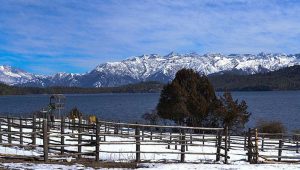
Best Time to Visit Rara Lake

How to Reach Rara Lake From Talcha Airport?
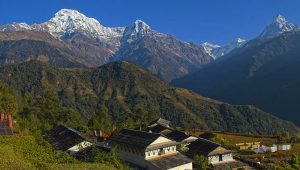
Ghandruk to Mardi Himal – How to Reach Mardi Himal from Ghandruk?

Short Treks in Nepal
Related trips you might interested in.

Upper Mustang Trek (3810 m)
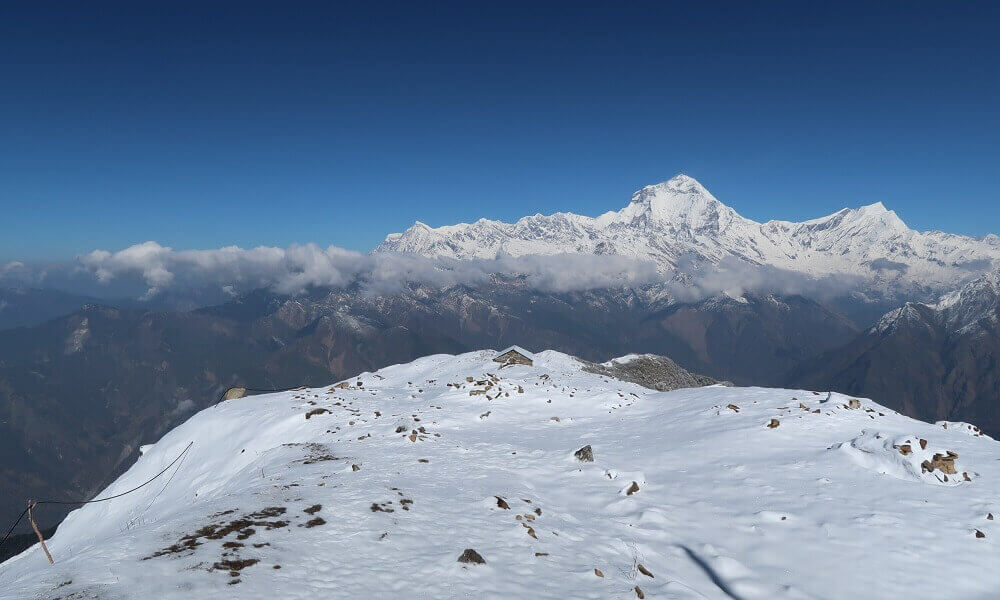
Annapurna Khayer Lake Trekking 14 Days Itinerary

Numbur Cheese Circuit Trek (4,880 m)

- Trekking in Sikkim Region
SIKKIM KANCHENJUNGA GOECHALA TREK- A ONCE IN A LIFETIME EXPERIENCE
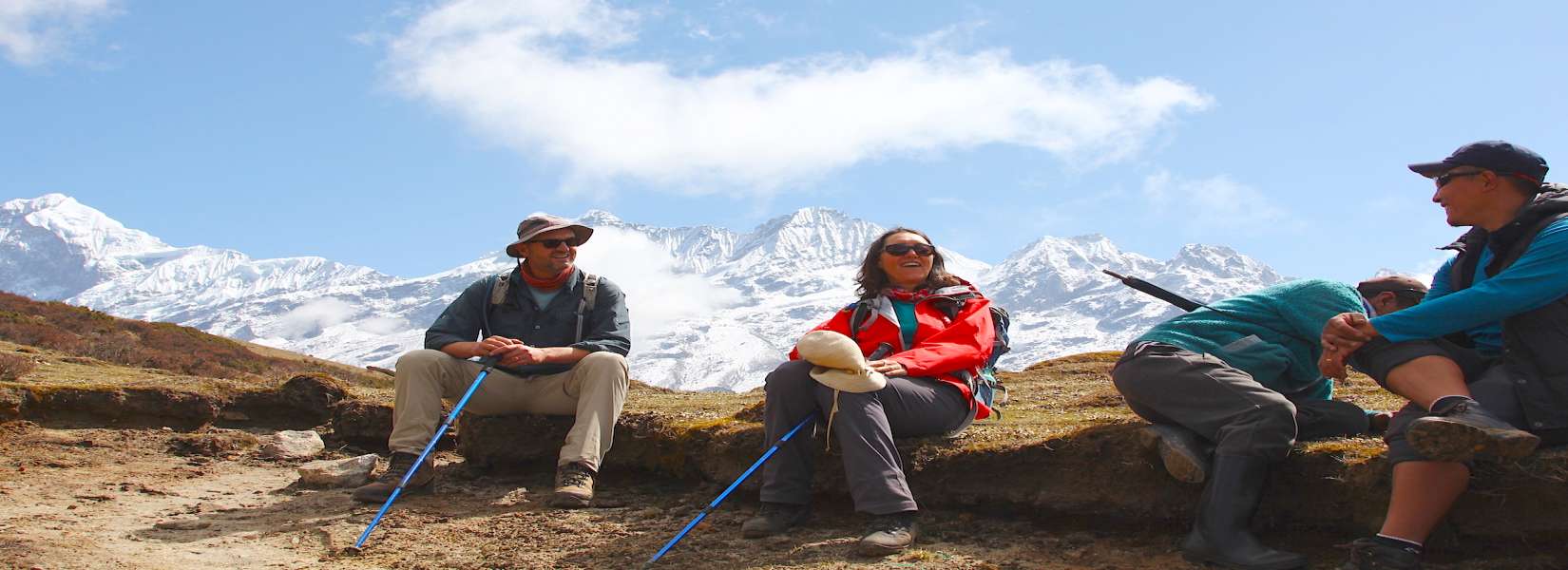
Goechala trek in Sikkim - blog
- May 20, 2021
- Ashmita Trek & Tours
Mountains are the solution to all problems. It seeps your deepest fears, anxieties, and frustrations of modern-day existence. To traverse through the valleys and ridges of endless beauty and to breathe in unpolluted fresh air is indeed an exciting chore. Hence, trekking is steeped in life-altering experiences. It not only offers physical rejuvenation but also widens your mental space as you come closer to the mysteries of the cosmos while gaining a truly new perspective.
Sikkim Kanchenjunga Goechala Trek is fraught with divine experiences and is one of the most offbeat trekking destinations in India. Trace your way through the luscious meadows, sleek crystal clear streams, and a host of vibrant flora and fauna. Goechala trek is all about Nature untarnished wonders. Along with witnessing jaw-dropping views of the mighty mountains, you will also be reminded of your sense of being.
From the verdant forests of Yuksom to the effete landscapes of Tshoka, the way up to Goechala Pass is all about freshness and wilderness. At Goechala Pass (4940 meters), you will bear testimony to the south face of Kanchenjunga (8586 meters). You will find yourself as a tiny creature amidst the phenomenal mountain peaks reminding you of the fact that you are Nature’s most pampered child. After meeting our personnel, you shall begin your trek. Trek up through semi-tropical greenery, pristine rivers, and streams, enchanting waterfalls just below Prek Chu. From Tshoka, ascend the rugged terrains of Dzongri. From this point, course through Mount Pandim shadow till you reach Goechala.
The ultimate trekking point of Goechala will impart you an indelible view as you will catch a glimpse of the snow-covered mountains and the glaciated lake below. Most importantly, you will view Kanchenjunga (8586 meters), Talung (7349 meters), and Kabru (7353 meters) amongst several other peaks. This memory will remain etched in your mind for the days to come. Begin your descent and pass through the alpine terrains and rugged lowlands till you reach the starting point of your trail, Yuksom. Our vehicle will then take you on a trip across Gangtok for sightseeing. As promised, the trek will surely impart a scintillating experience.
Table of Contents
Detailed itinerary.
DAY 1: ARRIVAL AT BAGDOGRA AIRPORT AND TRAVEL TO YUKSOM, 7 HOURS Our team member will welcome you at Bagdogra Airport or NJP Railway Station and take you to Yuksom. The road will take you through the tiny hamlets. You will travel via Teesta, Malli, Jorethang, and Tashiding. Reach Yuksom, a historical town in West Sikkim. It used to be the capital of Sikkim and one will find this place steeped in culture. The town is notable for trekking and hiking and also acts as a gateway to Kanchenjunga National Park.
DAY 2: TREK FROM YUKSOM TO TSHOKA, 6 HOURS Today our Sikkim Kanchenjunga Goechala trek shall commence. Walk along the Rathong River and trek through a verdant forest cover of magnolia, fern, and other kinds of orchids. Devote yourself to the wonders of nature like the chirping of birds and fresh mountain air. After trekking a bit more, reach Tshoka, a Tibetan refugee settlement. Spend overnight in tent camp.
DAY 3: TREK FROM TSHOKA TO DZONGRI, 6 HOURS After leaving Tshoka, take a steep climb through the colourful forests till you reach Phedang. The trail is smooth. Take rest in Phedang and keep trekking till Dzongri. After setting up our camp in Dzongri, we climb up the scanty meadows, if your body permits. Here, you can view Koktang, Rathong, Kabru, Kanchenjunga, Simvo, and Pandim. These small hikes help us to warm up our bodies. Spend overnight in the tent.
DAY 4: REST IN DZONGRI Spend the day in Dzongri, resting or acclimatizing by climbing nearby smaller peaks. This is to train you for the upcoming days which will include difficult treks. Spend overnight in tent camp.
DAY 5: TREK FROM DZONGRI TO THANGSHING, 5-6 HOURS After having breakfast, ascend the breathtaking landscapes till you reach Thangshing at about 4,115 meters where you will catch an uninterrupted view of Kanchenjunga and Pandim. You will also get to witness prayer flags. After spending a leisurely time skim through the rhododendron forest covers till you reach the Prek Chu River at 3,749 meters. Enjoy lunch in tranquility amidst the romantic scenery. After lunch, cross a river and trek through pine trees till you reach the camping spot. Spend overnight in tent camp under the majestic Pandim peak.
DAY 6: TREK FROM THANGSHING TO LAMUNEY, 3-4 HOURS Today it’s going to be easy and we must also prep for tomorrow as it is going to be a tad difficult. Walk along the Prek Chu River that is until you reach the azure Samiti Lake. The lake is a deviation from the monotony of mountainous views. It resides amidst bright prayer flags. Spend overnight in tent.
DAY 7: TREK FROM LANUMEY TO KOCHRUNG VIA GOECHALA PASS, 6-7 HOURS It’s a brand new day today and a massive journey waits ahead. To make most of the weather, we will start early in the morning. Ascend the steep hill of Lamuney that is imbued with views of a glacial lake. We shall now trek through the Zemathang Plateau that is above Samiti Lake. This plateau is shrouded in the shadow of Pandim. Climb a height of 15,700 feet and look at the gorge below for an enchanting look. From here, the Goechala Pass is an hour trek.
DAY 8: TREK FROM KOCHRUNG TO TSHOKA VIA PHEDANG, 6-7 HOURS Wake up early in the morning for a breathtaking Sunrise view amidst the mountain ridges. The golden hues falling on the snowy mountain ridges will surely render you speechless. View Kanchenjunga and the Goechala Pass and then depart from the campsite for Phedang. To arrive at Phedang, you need to course through the jungles of Prek Chu. Halt for lunch before descending to Tshoka. Spend the evening at rest and overnight in tent camp.
DAY 9: TREK FROM TSHOKA TO YUKSOM, 5-6 HOURS The last day of the trek is all about nostalgia as we trek through the same path as we did on our first day. This sense of familiarity will be elevated further as you come across the lush green vibrant views yet again. Get the chance to explore anything that you may have missed the last time. Check into the hotel and spend overnight at the hotel.
DAY 10: FAREWELL After breakfast, our representative will drop you at Bagdogra Airport or NJP Railway Station for your next destination.
- Stand on Goechala and witness a panoramic view of Mount Kanchenjunga
- Enjoy the sceneries and variegated fauna on your trek
- Come closer to the local culture
- View the emerald waters of Samiti Lake
- View Mount Pandim and get a chance to camp underneath its unclimbed peaks
HOW TO REACH?
For the Sikkim Kanchenjunga Goechala trek, you can book flights to Bagdogra Airport or take a train to reach New Jalpaiguri Station (NJP). From there, you will be escorted by our team member and take a ride to Yuksom- the starting point of our trek.
BEST TIME TO VISIT
The Goechala trek is best undertaken from April to June and September to October. The weather remains pleasant and the sky remains clear. As a result, there will be no hindrances on your way. Also, these months are ideal for nature lovers because the landscape offers stunning views of the most vibrant flowers, meadows, and forests. The temperature ranges from 8 to 17 degrees making the trek seamless and enjoyable. The Himalayas are the most enchanting creation of the universe and trekking to any of its mountain peaks is nothing short of a blessing. Trekking imparts a sense of self and must be undertaken at least once in your life.
Sikkim Kanchenjunga Goechala Trek has no dearth of surprises for trekkers. At Ashmita Trek and Tours, we make sure that you explore every nook and corner and come back for more. Do not delay. Join us today for this amazing retreat back to Nature.
Why Choose Ashmita Trek & Tours
We consistently provide five-star quality tours to each client. Our philosophy is aimed not just to give you the best time in a specific place, but also to enrich your life and perhaps change the way you look at the world. We provide itineraries that are best suited for your style and preferences. When you travel with Ashmita Trek & Tours, you get what you pay for. There are no hidden costs or extra fees and our guides are top-notch. They are professional, experienced and have lead trips throughout India. We are particularly excited about our Golden Triangle Tour and we hope that you are too! You can travel with confidence when you join Ashmita Trek & Tours, so book your extraordinary Goechala Trek in Sikkim today.
- Best Treks in India Hiamalayas
- travel Guide to Sikkim
- Trekking in Sikkim
Send an Inquiry
Recent posts.
- We got Honored by 2023 Traveler's Choice Award and 2023 Certificate of Excellence
- How to Choose the Best Trekking Company for You
- Sikkim Goechala Trek in Spring : (March to May), 2024 and 2025
- Sikkim Goechala Trek in Winter : September, October, November, December 2023 and 2024
- Best Base Camp Treks in Nepal, 2023/2024- EBC & ABC Treks Guide
Related Posts
- SINGALILA PHOKTEY DARA TREK BLOG
- Top 7 Best Treks in Sikkim - | Sikkim Trekking Guide
- Best Adventures in Sikkim
- Altitude and Health Tips
- Annapurna Region Trek Blog
- Company Achievement
- Culture and Lifestyles
- Darjeeling Singalila Region Trek Blog
- Darjeeling Travel Guide
- Everest Region Trek Blog
- Himalaya Green Trails
- Himalaya Trek Gear Review
- Himalaya Trekking Tips
- India Travel Guide - Perfect Introduction to India
- Langtang Region Trek Blog
- Latest Updates News
- Nepal Travel Guide
- Nepal Trekking
- Offbeat Trek in Darjeeling
- Official Updates
- Sikkim Travel Guide
- Travel Experience
- Uncategorized


- Holiday Overview
- Cost & Services
Kanchenjunga Base Camp Trek is a 15-day, 161-kilometer-long trekking package in Sikkim, the best base camp trek in Sikkim well worth your effort and time. A trek in Sikkim, tailored for those who crave adventure and are no strangers to strenuous hikes.
Trekking to the Kanchenjunga Base Camp is also a great option for anyone looking for an out of the world trekking experience in Sikkim, that can compete with the best base camp trek routes in India.
Also known as the Sikkim Kanchenjunga Trek, this is an adventurous trek package that cris-crosses through some of the most pristine and untouched parts of the Sikkim Himalayas.
A high-altitude trekking route in Sikkim to the south-east base camp of Kanchenjunga, but with ample breaks for acclimatization, thus making it safe to trek.
A classic trek package in India, the Kanchenjunga Base Camp Trek takes you through high passes, clear mountain lakes, and meadows along the Singalila Ridge that straddles the border between Nepal and India. A challenging trek, but the best base camp trek in Sikkim, to mention the least.
A thrilling trek package in Sikkim, the Kanchenjunga Base Camp Trek offers great views of the Himalayas and gorgeous alpine meadows. Cross the snow-covered Dafey Bhir Pass, adorned with spectacular mountain views, and enjoy a full day of exploration while in Dzongri.
April to May is the best time for this trek in Sikkim, when Kanchenjunga National Park comes alive with a riot of colors, making it the right time to trek.
May brings with it the anticipation of the approaching monsoon season, with occasional rain-bearing clouds drifting around the mountainside.
For those seeking unparalleled mountain views, October to November is the perfect time for the Kanchenjunga Base Camp trek in Sikkim , when the mountain views are exceptionally clear and crisp, providing breathtaking panoramas.
Easy and flexible as per your convenience
We will keep your information confidential.
- INDIA Farout Trek Upper Chiboo Approach Road, Kalimpong-734301 Darjeeling. West Bengal NEPAL Climb High Himalaya, 1st.Floor, Sagarmatha Bazaar, Mandala Street, Kathmandu-Nepal
- Call (INDIA): +91- 9933975902 +91- 6294972671 WhatsApp Me: + 91-9933975902 NEPAL-+ 977-9803001116
- Email us: [email protected]
- Altitude Sickness: Symptons & Remedies
- 14 Best Tips a Hiker Should keep in mind
- 5 Best Tips to Remember before Heading Outdoors
- Buying the Right Travel Insurance
“Unlock the Mystery of Kanchenjunga Base Camp Trek with Farouttrek—A 15-Day trek in Sikkim to the Home of Endless Delights!”
Kanchenjunga Base Camp Trek—there’s a mystery in the name, a promise of delights where the monsoon and winter seasons keep pace with relentless time. The destination of the Kanchenjunga Base Camp Trek in Sikkim is not only the Goechala Pass or the south-east base camp at the foot of the iconic Kanchenjunga, but also the hillsides decorated with exotic rhododendron flowers and the horizon adorned with the Everest and Kanchenjunga Range from day one. And as the 161 km and 15-day-long Kanchenjunga Base Camp Trail passes through moss-laden pine and fur forest, you can experience the pure fresh air with every breath.
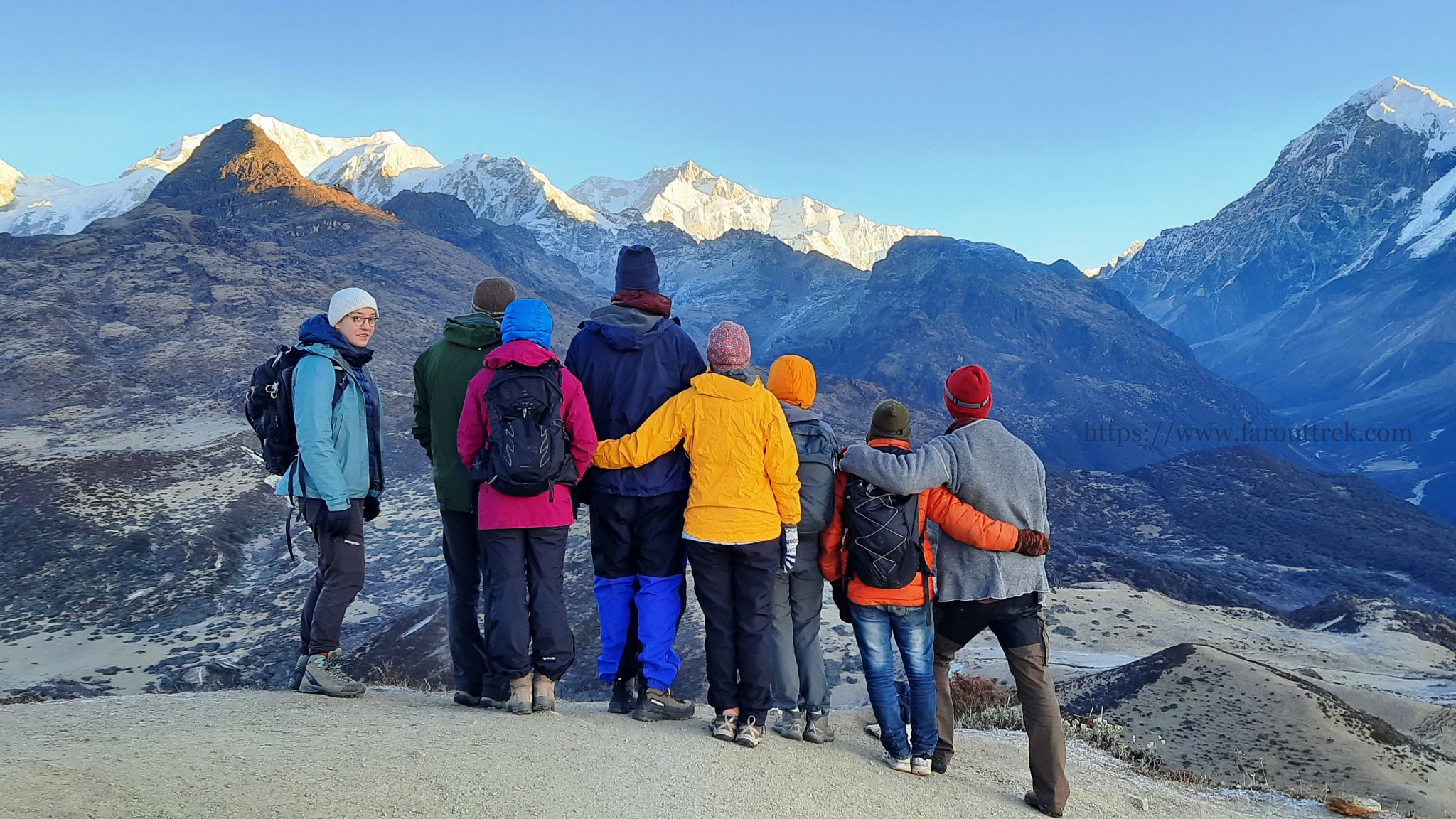
How long is this trek?
The Kanchenjunga Base Camp Trek is a 15-day and 161-kilometer-long trek in Sikkim to the south-east base camp of Kanchenjunga, India’s highest mountain. A fifteen-day hike in Sikkim, through the great Himalayan trail of Kanchenjunga National Park rarely visited.
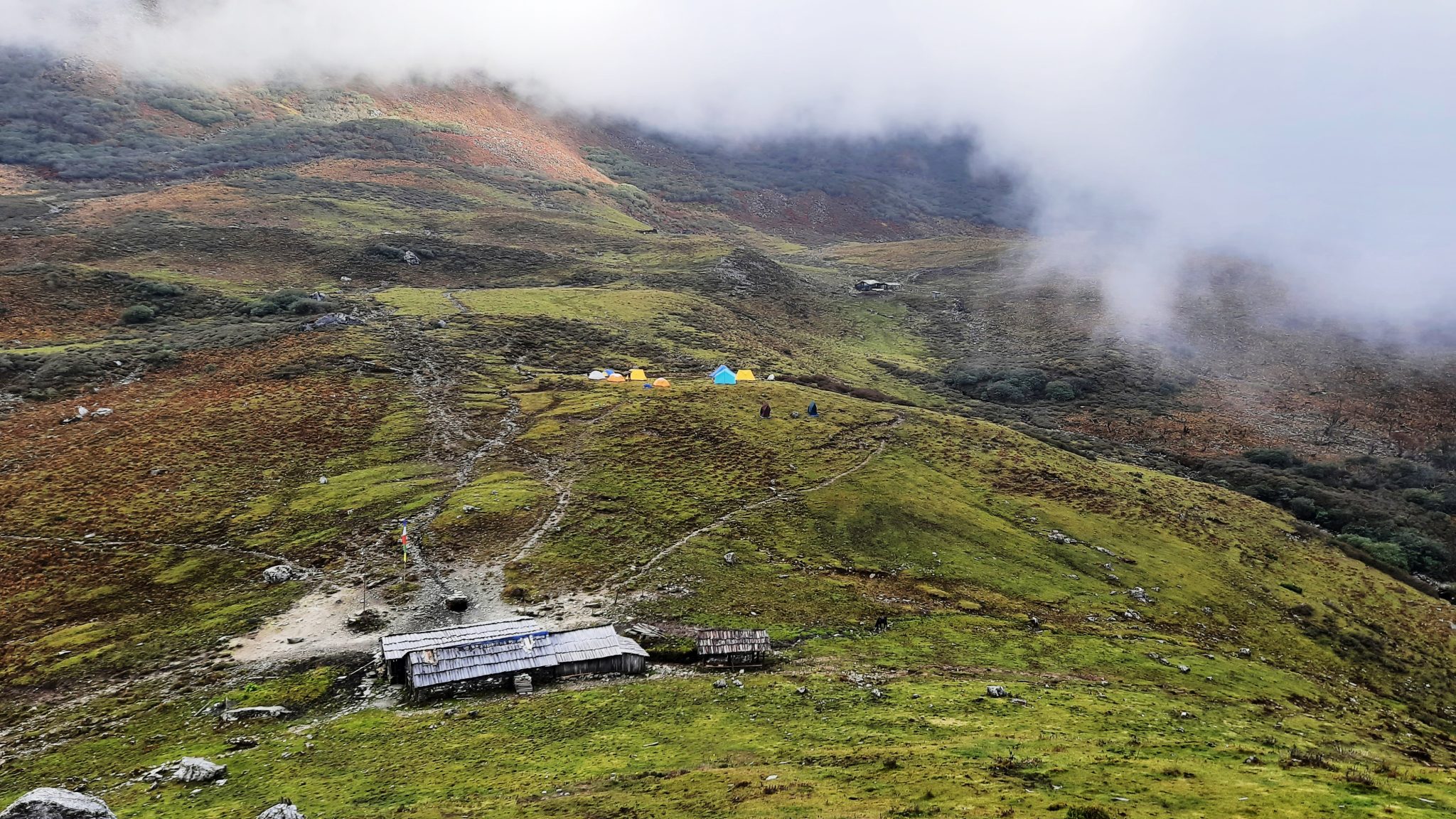
Getting Around
Kanchenjunga Base Camp Trek located in Sikkim, and the trek head, Uttaray, is a distant five-hour’s drive from Gangtok. While Yuksom where the trek ends, takes six hours drive to Bagdogra Airport or New Jalpaiguri Railway Station and five hour’s drive to Gangtok, the capital of Sikkim.

On the Kanchenjunga Base Camp Trail
The trail on the Kanchenjunga Base Camp Trek is a walkable cobblestone path through forests littered with lakes, at times a little steep, till we reach Dafey Bhir Pass (4330m), the highest point on the Sikkim side of the Singalila Ridge. As the trek gently starts from Uttaray and reaches Chewabhanjyang, the Kanchenjunga Base Camp Trek slowly unfolds; the entire valley on the Nepal side and as well on the Sikkim side, along with Everest, three sisters, and the Kanchenjunga Range, can be surveyed with ease.
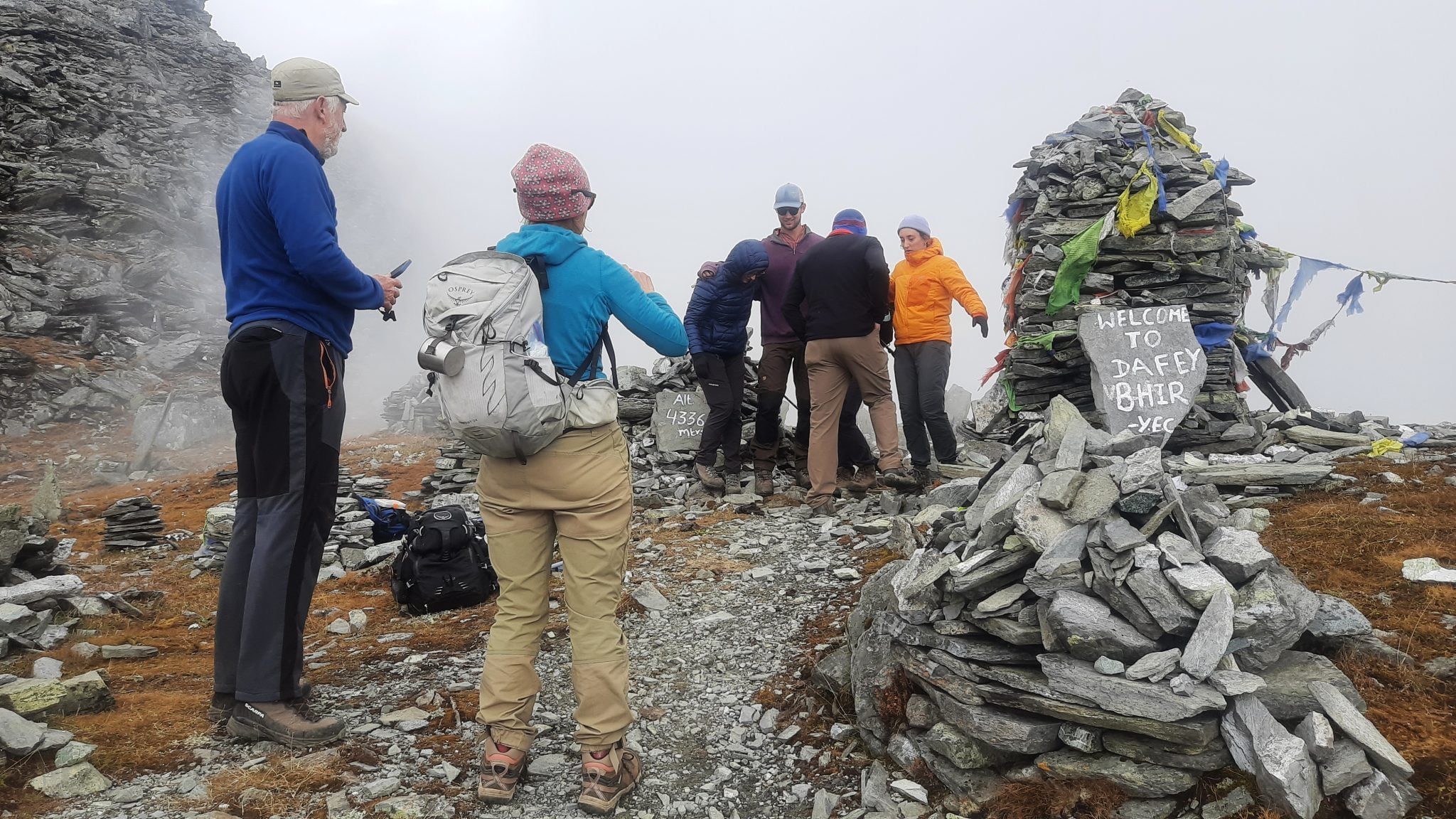
Although the final destination that you are headed for is the Kanchenjunga Base Camp at Goechala Pass, you will notice that the entire hiking trail is made up of beautiful mountain scenery and natural wonders. The very first thing that you notice once you are on the Sikkim side of the Singalila Ridge, at Chewabhanjyang, are the Himalayan views and then the crystal-clear alpine lakes as you approach Dafey Bhir Pass. Scenery like out of a nature magazine.
View from Daphey Bhir Pass

The Kanchenjunga Base Camp Trek, especially on the day while crossing the Dafebhir Pass (4330 m), is truly otherworldly, as you have an incredible view over the Everest and the Kanchenjunga Range along the way. Another vital part of the trek to the Kanchenjunga Base Camp is the local cultural experience. You get to engage with the local Yak herders along the trek route, getting an opportunity to share a cup of tea with them. If you have limited time, then there is also a shorter variation of this trek, the eight-day and 80-km Goechala trek.
Not only the views and the trail, but also the smiling demeanor and the mannerism of the people of Sikkim make the Kanchenjunga Base Camp Trek refreshingly different from all other trekking trails in the Himalayas. Every turn and bend beckons one to stop and admire the unusually long Himalayan Range. The Peaks rising from the sea of clouds and sometimes cloudless right from the bottom, indeed an enduring scene. A peculiar dreamy feeling will envelop the onlooker, and the surroundings will appear surreal. The world may have taken a different garb now, but the charms and magic of the Kanchenjunga Base Camp Trek still hang in the air.
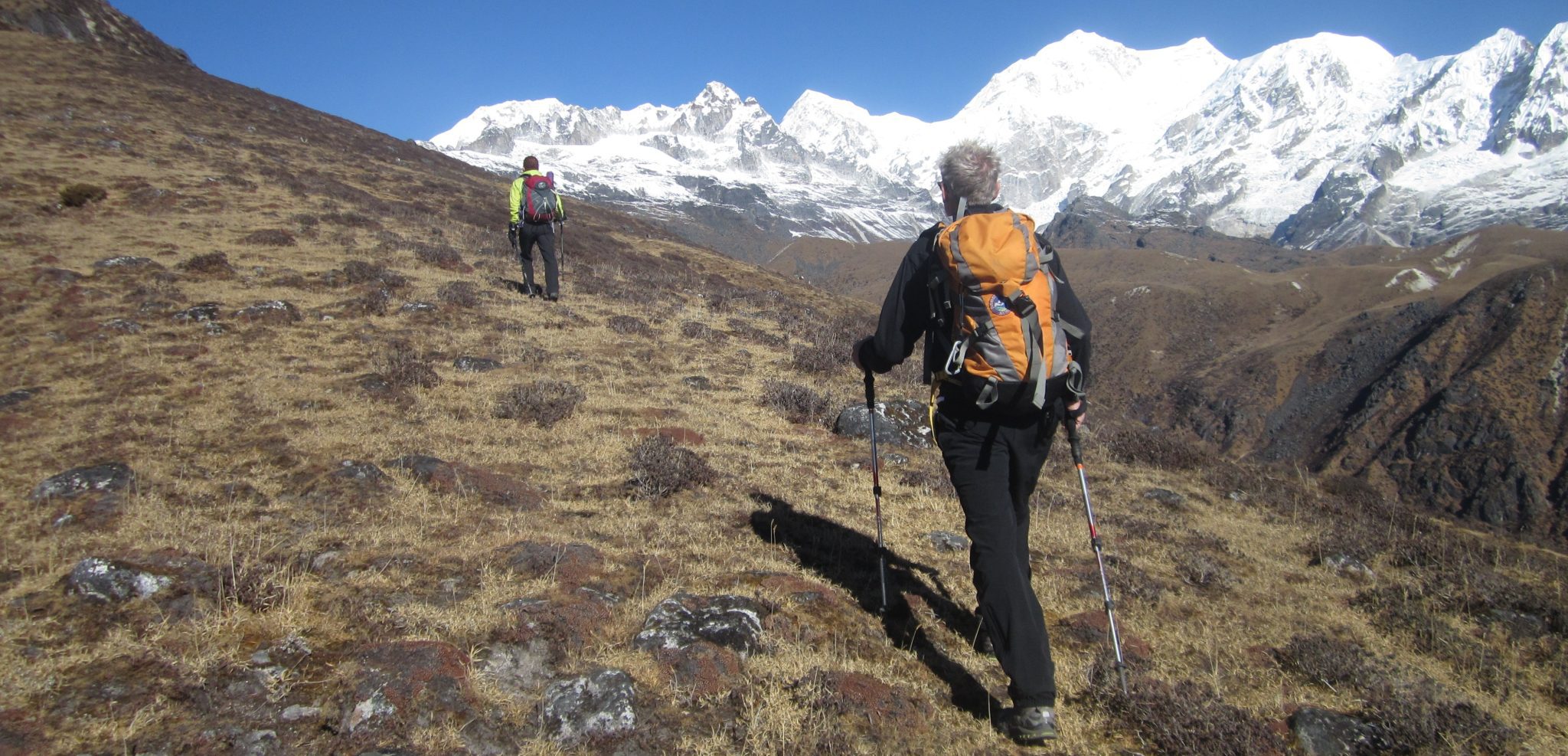
How hard is the Kanchenjunga Base Camp Trek?
The trek to Kanchenjunga Base Camp is the most beautiful trail to hike in the Sikkim Himalayas. But it is also among the most strenuous of the trekking trails in Sikkim and, at times, very challenging.
The Uttaray Chewabhanjyang Circuit route to the Kanchenjunga Base Camp is the strenuous route up and arguably the best hiking route in Sikkim. That’s because the Kanchenjunga Base Camp Trek is a combination of all of the best elements of the other routes rolled into one fantastic hike.
If you’re looking for beautiful scenery, plenty of solitude, a healthy challenge, and the potential to spot wildlife, this is definitely the route for you. This path is virtually devoid of other trekkers, and as a result, the campsites are quiet, peaceful, and practically deserted.

A solitary Trek
Because the Uttaray Chewabhanjyang Kanchenjunga Base Camp trek route is longer than the other trails in Sikkim, it gives trekkers a chance to take in more of the mountains of Sikkim. Not only do they get a chance to hike across the awe-inspiring landscape of the Sikkim Himalayas, but they’ll also catch views of the Everest Range and the Kanchenjunga Range along the way.
The Kanchenjunga Base Camp Trek also provides amazing views down onto the open valleys of Nepal that are found to the north of the trail, something that is seen by only a handful of other hikers while trekking on the Kanchenjunga Base Camp Trail.
Best Season
For those planning the Kanchenjunga Base Camp Trek, the period from April to May is ideal, as the Kanchenjunga National Park is adorned with a colorful array of flowering plants in full bloom. The high meadows come alive, creating a mesmerizing sight for trekkers to behold.
In May, the approaching monsoon season brings some rain-bearing clouds around the mountainside, adding a touch of dramatic beauty to the landscape.
On the other hand, for unparalleled mountain views, October to November is the ideal season for the Kanchenjunga Base Camp trek in Sikkim. During this time, the mountain views are remarkably clear and crisp, providing trekkers with breathtaking scenery to admire.
Accommodation and Food
The Kanchenjunga Base Camp Trek in Sikkim offers a camping experience, as no settlements are permitted within the Kanchenjunga National Park. Guests will be provided with twin shared sleeping tents (A-Tent or Dome Tent) furnished with three-inch foam mattresses for comfortable nighttime use.
In addition to the sleeping tents, there will be a kitchen tent for cooking, a dining tent, and a toilet tent exclusively designated for guests’ use. The dining and kitchen tents also serve as accommodations for the support team.
Throughout the trek, guests can expect to enjoy local vegetarian food such as Dal, rice, and curry as their main diet. For lunchtime meals, they can look forward to other food options, including chowmein, noodle soup, macaroni, and chapatis (bread).
Breakfast offerings typically include porridge, bread with jam and butter, pancakes, eggs, fruits, coffee, or tea. As for dinner, it usually consists of rice dal vegetable curry soup followed by hot chocolate drinks.
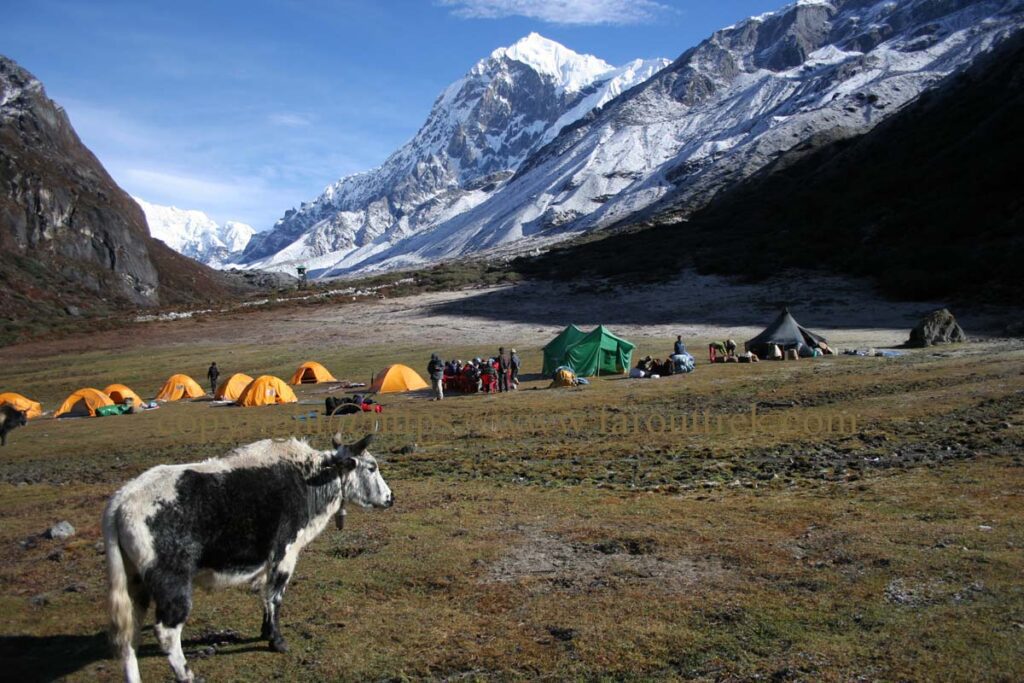
Mobile Connectivity and Power
The Kanchenjunga Base Camp Trek Route does not have electricity, so it’s important to bring plenty of battery banks or extra batteries for your camera. A portable solar charger will be very useful on this trek in Sikkim.
Mobile connectivity is extremely limited along most parts of the route, with some areas having no signal at all.
What to Carry
A spacious haversack (50–55 liters) for carrying all your clothes, necessary items, and a sleeping bag. This will be carried by the ponies.
Also carry a personal day pack for day use that has enough room for an umbrella or raincoat/poncho, a water bottle, a light fleece, and a windbreaker. Don’t forget to bring polarized sunglasses as well.
Include your personal medical kit in the day pack. It should contain medications for fever, dysentery, anti-acidity (Gelusil), altitude sickness (Diamox tablets), antiseptic cream, sunscreen lotion, vaseline, painkillers, crepe bandages for sprains, waterproof band-aids for cuts, bruises, and toe blisters.
As waterborne diseases are common while traveling, carry water-purifying tablets, even if boiled drinking water is provided daily.

Kanchenjunga Base Camp Trek is a high-altitude trek in Sikkim that will see camping at 4000 m for some days at a stretch, where the temperature, especially at night, will drop to minus degrees Celsius. Therefore, include in your pack a woolen pullover or thick thermal jacket, a down jacket, woolen socks, and thermal inner wear. Also, include woolen or wind-proof thick gloves or mitton and balaclavas for evening use.
The daytime temperature will range between 6 and 18 degrees Celsius. Therefore, carry along a windbreaker and a light fleece for day use, along with a couple of quick-dry T-shirts and light trekking pants for day use.
Last of all, an ankle-high Comfortable and durable trekking boots are a must, as the terrain is rough and uneven from Yuksom to the Kanchenjunga Base Camp. If you have recently purchased this pair of hiking boots, then be sure to break into them before trying them out on the Kanchenjunga Base Camp Trek.

Support Team
The support team for a two-member group will consist of a cook supported by two kitchen helpers. A sherpa to take care of the tents, ponies to carry the camping equipment and baggage of the hikers, food and other essential items, and an experienced trekking guide.
Booking Procedure
To secure your Kanchenjunga Base Camp Trek, an advance deposit is required. Upon receiving this deposit, your booking will be confirmed. After expressing your interest in joining the trek, we will provide you with the necessary bank details for making the deposit.
Trekking Permits
Participants interested in undertaking the Kanchenjunga Base Camp Trek must book through a Tourism Department-registered agency in Sikkim. The trekking permits will be issued under the agency’s name and are available for a minimum of two persons.
Inner Line Permit (ILP) for Foreign Visitors
Foreign travelers wishing to trek and tour in Sikkim must obtain an Inner Line Permit, which is based on their Indian Visa for entry into the country. This permit can be obtained at border crossings between West Bengal and Sikkim, including Rangpo and Melli, as well as at specific locations such as Siliguri’s Sikkim Nationalised Transport office and Sikkim House in Delhi or Kolkata. The initial permit is valid for fifteen days but can be extended by another fifteen days while staying in Gangtok.
13 Best Tips to remember for the Kanchenjunga Base Camp Trek
- Keep Your Feet Comfortable: Get yourself a pair of light ankle-high trekking boots. The ankle cuff should not be too high to avoid damaging your achilles. Try these boots on early before you actually embark on the Kanchenjunga Base Camp Trek, and break into them early so that you do not get blisters while on the trek.
- Get proper supportive socks: Get socks that are designed for trekking and hiking long distances. These socks are well worth investing in to give your feet extra protection on the Sikkim Kanchenjunga Trek.
- Train Before Hand: The Kanchenjunga Base Camp Trek involves 15 days of hiking in high altitude at an average of 10 km of trekking per day. Therefore, it is important to train well before embarking on the Kanchenjunga Base Camp Trek. Training can include long walks, running, cycling, swimming, or any other physical activity that will improve your stamina and fitness.
- Train on a Range of Terrain: You will need to tackle a variety of terrain on the Kanchenjunga Base Camp Trek, from riverside trails to steep paths up a mountain trail filled with snow. Therefore, before you go on this trek in Sikkim, mix up your training with long walks on a variety of terrain.
- Acclimatize Well: It is essential to acclimatize properly as you trek to higher altitudes to prevent altitude sickness. Take regular breaks and spend extra nights at higher altitudes to give your body time to adjust.
- Remember to keep your muscles in good shape: It is important to stretch after long walks. Focus on your calves, quads, hamstrings, hips, and back.
- Practice with your backpack: Your main baggage will be carried by Porters/Pack Animals. But you will need to carry a day pack with you to put in all your essentials as well as personal items, like a passport, camera, water bottle, your personal medical kit, an umbrella, light fleece, and a wind stopper.
- Pack Your Bag accordingly: Your main baggage should not weigh more than 12/15 Kg in weight. But make sure to bring along warm clothes, woolen caps, woolen gloves, sun hat and waterproof Gears, comfortable trekking shoes, and other essential items needed for the Kanchenjunga Base Camp Trek. It is essential to include in your baggage first aid kit, water bottle, water purifying tablets, sunscreen lotion, Vaseline, sun glasses, spikes for use on the snow etc.
- Respect the Local Culture: The Kanchenjunga Base Camp Trek is home to the local people of Sikkim, who have their own unique culture and traditions. Respect their beliefs and culture, and be mindful of the impact that you will have on their environment.
- Stay Hydrated: It is important to stay hydrated at higher altitude to avoid altitude sickness. Therefore, drink plenty of water and avoid Alcohol and Caffeine.
- Take Your Time: The Kanchenjunga Base Camp Trek is not a race. So take your time and enjoy the scenery, and do not push yourself too hard.
- Prepare for the weather: The weather in the mountains can be very unpredictable. Therefore, be prepared for rain, snow and cold weather.
- Be flexible: Weather and other conditions can change very quickly in the mountains. Therefore, be flexible with your plans and be prepared to adjust your itinerary accordingly.
—– o0o —–
- Type of Trek : Camping Trek
- Minimum Number of Participants Required : 2 Persons
- Trek Grade : Moderate to Strenuous
- No. of Days on the Trek : 15 Days
- Total No. of Days : 21 Days
- Highest Point : Goechala Pass view Point (4775 m)
- Highest Camp Site: Pangdin (4210 m)
- Starting & Ending Point: Bagdogra Airport, NJP Rail Station, Nepal Border
- Group Departure Dates: We do not have group departures for the Kanchenjunga Base Camp Trek. Only a private trek for a minimum of two people can be arranged on a date of your choice. Customized private treks are also available for this trek.
SIKKIM KANCHENJUNGA BASE CAMP TREK ITINERARY Day 1: Arrive at Bagdogra Airport. Drive to Gangtok (4 hours). Overnight Hotel (B/B only).
Day 2: A Day in Gangtok.
After a hearty breakfast, it’s time to drive to Rumtek Monastery, located 23 kilometers from Gangtok. This monastery was built by the 16th Gyalwa Karmapa in 1959 and is a replica of the Tsurpu Monastery in Kham, Tibet. It is the biggest monastery in Sikkim and the seat of the Kagyu sect of Tibetan Buddhism. It also serves as a school for the monks in Sikkim. This monastery is a must-see for any visitor to the state. Its walls are adorned with intricate murals and golden statues of the Buddha, and it is an awe-inspiring sight to behold. Visit the Institute of Tibetology, which contains some ancient Buddhist scriptures and artifacts. In the meantime, our staff will process the trekking permit for the Kanchenjunga Base Camp Trek.
Day 3: Drive Gangtok to Pelling (1800 m/5-6 Hrs. Drive). Overnight Hotel.
Day 4: Acclimatization half-day walking tour of Pelling. Afternoon drive to Uttaray, the trek head for the Kanchenjunga Base Camp Trek (2012 m/35 km/2 hours).
Visit the Pemayangtse and the Sangacholing Monasteries. The two holiest and oldest monasteries in Sikkim.
Day 5: Sikkim Kanchenjunga Trek Starts. Trek Uttaray to Chewabhanjyang ( 3200 m/14 km/5-6 hours). Overnight Tents.
After the entry formalities are done, the Kanchenjunga Base Camp Trek from Uttray to Chewabhanjyang begins on a wide trail through a tropical, moss-laden pine and conifer forest decorated with ferns and lichens. This forest is home to wild animals like bears, musk deer, and hares.
Chewabhanjyang is a pass between Nepal and Sikkim, where trade between the two countries used to take place. As a result, the Indian Army has stationed security forces here. There is a police post on the Nepal side of the border too. The first day of the Kanchenjunga Base Camp Trek is a challenging one, with a lot of uphill climbing until you reach Chewabhanjyang.
The altitude gain on the first day of the trek is 1100 meters, and it can be tough if you’re not used to this kind of terrain. However, the views of the surrounding mountains, the lush forests, and the unique wildlife make the effort worthwhile
Day 6: Acclimatization Day. Side Trek to Phoktey Dara on the Singalila Ridge. Overnight Tents.
The second day of the Kanchenjunga Base Camp Trek starts with an acclimatization trek to Phoktey Dara and Singalila Pass, the two highest points and the best trekking destinations in Sikkim for brilliant views of Everest and the Kanchenjunga Range. The trek starts early in the morning to catch the sunrise views of the mountain range. Return back to Chewabhanjyang for the night. Overnight Tents.
Day 7: Trek Chewabhanjyang to Gairi (3600 m/10.5 km/5 hours). Overnight Tents.
With a gain in altitude of 400 meters, the trail of this day of the Kanchenjunga Base Camp Trek starts climbing gently through pine and rhododendron forests, accompanied by the presence of the two dominant peaks of the Kanchenjunga Range.
This picturesque landscape is one of the most beautiful in the Sikkim Himalayas, making Sikkim an ideal destination for a trek. As you traverse through the forests, you’ll experience the serenity of the mountain atmosphere and be able to take in the majestic views of the mountain range.
With the gentle altitude gain and views of the mountain range, today is a pleasant day for the trek. You’ll be able to take in the fresh air and admire the spectacular views of the snow-capped peaks.
Day 8: Trek Gairi to Dhond (3900 m/6 km/3 hours). Overnight Tents.
The trail from Sikkimey Gairi immediately begins to climb with a 300-meter gain in altitude to Dhond. The trail offers spectacular views of the Kanchenjunga range, and the trail meanders through the rhododendron forest, giving way to Alpine vegetation as the trail reaches Dhond at 3900 meters. The trail is lined with Primula flowers, making it a picturesque journey through the Himalayan region.
Day 9: Trek Dhond to Paharae Megu (3800 m/12 km/5 hours). Overnight Tents.
Located in a lush green meadow and surrounded by rhododendron forests on all sides, Paharey Megu is a stunning camp site. A five-minute walk up to the ridge on the India-Nepal border offers an awe-inspiring view of the Kanchenjunga range as the sun rises. This mesmerizing sight is a must-see for any trekker and a sight to cherish.
The eighth day of the Kanchenjunga Base Camp Trek is relatively easy, with no gain in altitude. It is a slight uphill and downhill trek through the rhododendron forest until you reach Paharae Megu, the camp site for the night. Along the way, you will be surrounded by the beauty of the remote and isolated landscape of the Sikkim Himalaya.
Day 10: Trek Paharae Megu to Jomlae Pokhari (4100 m/11 km/5 hours). Overnight Tents.
The 9th day of this trek is an amazing one, thanks to the spectacular views of Kokthang and the Kabru sisters. The trail is wide and easy to follow for about 1 km, and then the trail starts climbing for an hour. Then the trail levels out on a wide stone trail till the Twin Lakes, which also form the border between India and Nepal. This is where we stop for lunch. On the other side, one can see the small settlement of Timbong Pokhri, which falls inside Nepal. The hard trek uphill is compensated by the many lakes that are dotted along the trail, and the 300-meter gain in altitude at above 4000 meters will certainly give you an adrenaline rush. After lunch, it is a slow and steady climb to Dafey Bhir Pass and then a gradual drop down to Jomlae Pokhari, our camp site for the night.
The trail on the 9th day of the Kanchenjunga Base Camp Trek is definitely one of the most beautiful and memorable of all the days. The views of the majestic mountains from Dafey Bhir Pass, the lush green valleys, and the many lakes that dot the mountainside give you that calming atmosphere of the Himalayas, and all these come together to give you an unforgettable trekking experience. Overnight Tents.
Day 11: Trek Jomlae Pokhari to Yangshyap (3543 m/9 Km/4 hours). Overnight Tents.
From Lam Pokhari, the trail takes you steadily and immediately up the mountain, passing through boulder-strewn paths that eventually lead to the Dafey Bhir Pass, located at an altitude of 4330m. The views a little away from the pass are nothing short of breathtaking, with the full range of the Himalayan mountains from Everest to Kanchenjunga in full view. Once at Daphey Bhir Pass, you become an ethereal part of the most beautiful 180-degree view of the Everest and the Kanchenjunga Range. It is moments like these that make up the Kanchenjunga Base Camp Trek in Sikkim. Moments that are meant to be bottled up and cherished forever.
From here, the path then starts to descend for about three kilometers, taking you through valleys and meadows as you make your way towards Gomathang. The last two kilometers of the trail are a steep descent, but the effort is well worth it when you reach Gomathang, where you can take a break for lunch.
After lunch, the trekking trail starts climbing immediately for about 2 km through thick pine forest. The trail then gently descends till Yangshyap, our camping ground beside a small stream for the night.
Day 12: Trek from Yangshyap to Pangdin (4210 m/10 km/5-6 hours). Overnight Tents.
The trek to Pangdin, with a total distance of 10 km and an altitude gain of 710 m, is perhaps a gentle day of trekking on the eleventh day of the Kanchenjunga Base Camp Trek. The gentle uphill trek passes through dense tropical forest and starts climbing subtly from the time we start the trek. With the views of Pandim, Thinchenkhang, and Narsing visible on the right flank. The mountain view does compensate for the long trek through the forest. Except for the last 2 km of uphill before approaching Pangdin, the entire day of trekking is moderate in nature. The altitude gain of 700 m cannot be felt either.
Day 13: Trek Pangdin to Bikhbari (3900 m/9 km/5 hours). Overnight Tents.
The trek route from Pangdin to Bikhbari is a pleasant experience for your aching leg muscles, as it is not difficult and there is no sudden gain in altitude. As you traverse through the route, you’ll pass through Tyigabla and Rathong Valley.
Tyigabla holds immense significance to both Buddhist pilgrims and travellers alike. It is said that Guru Rimpoche, the enlightened Guru, used this route on his way to Nepal and Tibet while propagating Buddhism. It is also a route used by travellers to enter Nepal.
The most difficult part of the trek on this day is after lunch. It is a sheer uphill climb of a little more than an hour on a small trekking trail woven out on a wall. This part of the climb is treacherous, but after the climb, the scenery is beautiful, and the rest of the trek to our camp site at Bikhbari is an easy downhill trek.
Also, from Pangdin, the morning views of the snow-clad mountains of the Kanchenjunga Range are just spectacular to behold. From the ridge, you can even spot the Dzongri Campsite.
Day 14: Trek Bikh Bari to Dzongri (4030 m/8 Km/4 hours). Overnight Tents.
This is a short trek to Dzongri Ridge and an easy trek too, with a very gradual uphill trail till Dzongrilla Pass. From this pass, you can look down at the valley floor and the white peaks of Rathong, Kang, Frey Peak, and the Kabru sisters above the Himalayan Mountaineering Base Camp. From here, the trail dips slowly until we reach the camp site at Dzongri, 2 km away.
Day 15: Rest Day at Dzongri.
One of the most rewarding experiences on the Kanchenjunga Base Camp Trek is the early morning hike to the Dzongri View Point, where you are welcomed by the most mesmerizing view of the Kanchenjunga Range. The view is especially rewarding during sunrise when the alpine glow colors the summit of Kanchenjunga, painting it all red, and it is here that you will truly appreciate the beauty of nature. After you’ve taken in the breathtaking views, your journey back to camp begins. Breakfast awaits you on your return, making this early morning hike one of the most enjoyable and rewarding experiences of your trekking experience.
Day 16: Trek Dzongri to Lamunee (4164 m/11 km/5-6 hours). Overnight Tents.
After breakfast, the trek to Lamunee begins. The trail starts with a gentle uphill climb on barren Alpine vegetation with mountain views in the distance for 1 km. The trail then dips down slowly for 2 km and then a steep downhill for another 2 km till you reach the river bed at Kookrochoong. From here, the trail meanders beside the river for a kilometer before gradually ascending through the Rhododendron Forest until you reach Thansing. The remaining 3.8 km of the Kanchenjunga Base Camp Trek are on a wide, level path, with Mount Pandim and Thinchenkhang ever present on your right, towering above you.
Day 17: Trek to Goechala Pass View Point and back to Kookrochoong (14 km/6-7 hours). Overnight Tents.
Trekking to the Goechala Pass View Point is an exhilarating experience that you don’t want to miss! This 15-kilometer roundtrip starts at 3 a.m. and takes you to a height of 15,500 feet. The Goechala Pass view point offers unparalleled views of the Kanchenjunga Range and is one of the most sought-after destinations on the Kanchenjunga Base Camp Trek.
This stretch of the trek requires a certain level of physical fitness. Before reaching the Goechala View Point, you will have to cross the sacred Samiti Lake at 4210 m. Once you reach the viewing point, you can witness the mesmerizing sunrise on the snow-clad peaks of the Kanchenjunga Range. After spending some time at the top, you will make your way back to the campsite at Lamunee for breakfast. After a well-deserved rest, you will head down the Thansing Valley in a leisurely manner and camp for the night at Kookrochoong.
Day 18: Trek Kookrochoong to Tchoka (2975 m/15 km/6 hours). Overnight Tents.
The trek to Tchoka from Kookrochoong is perhaps the easiest part of this trek in Sikkim. This part of the trek route is a paradise for nature lovers, boasting thick rhododendron and pine forests. With only a few uphill stretches until Phedang, where lunch will be served, the day’s trek is a great way to enjoy a leisurely hike in Sikkim.
After lunch at Phedang, the trek to Tchoka is a downhill journey on a rough trail as you make your way to the campsite at the end of the day. This part of the trek route gives a great opportunity to observe the lush green forests and vivid fauna of the well-preserved Kanchenjunga National Park in the Sikkim Himalayas.
Day 19: Trek Tchoka to Yuksom (1760 m/13 km/6 hours). Overnight Lodge.
Tchoka to Yuksom is an easy 13-kilometer trek through the dense forest of Kanchenjunga National Park. The first 3 km is a steep downhill, and then it is a little up-and-down hill trail till Yuksom, where the trek ends. End of the Kanchenjunga Base Camp Trek in Sikkim. Overnight Lodge.
Day 20: Drive to Kalimpong (124 km/4 hours). Overnight Hotel / Home Stay.
Day 21: Drive to Bagdogra Airport for Final Departure. The end of the Kanchenjunga Base Camp Trek
How much does the Kanchenjunga Base Camp Trek cost?
- Kanchenjunga Base Camp Trek Cost: US$1730 per person.
- Indian trekkers, Kindly Inquire for quotes in Indian Rupees
What is included and excluded in the cost?
KANCHENJUNGA BASE CAMP TREK COST INCLUDES:
- Hotel accommodation in Gangtok, Pelling, and Kalimpong: twin share, including breakfasts.
- Twin-share rooms in a lodge in Uttaray and Yuksom.
- Twin-share accommodation in tents while on the trek.
- Fully organized trek services with guide, porters, Ponies, tents, etc.
- Fixed three meals every day during trekking.
- All road transport is as per itinerary by car or Jeep.
- Service of an English-speaking guide.
- Entrance fees to monuments visited.
- Kanchenjunga National Park Fees.
- All Permits for Sikkim & Darjeeling.
DOES NOT INCLUDE:
- Sleeping bag; personal clothing or equipment.
- Lunches and dinners during hotel stays.
- Bottled or alcoholic drinks.
- Tips, client insurance, and evacuation costs.
- Any expenses of a personal nature.
NOTE: The above-given Itinerary is a sample, intended to give you a general idea of the likely trip schedule. Numerous factors, such as weather, road conditions, the physical ability of the participants, etc., may dictate itinerary changes either before departure or while on the trail. We reserve the right to change this schedule in the interest of the trip participant’s safety, comfort, and general well-being.
NOTE: The trek is a strenuous and high-altitude camping trek through the most uninhabited part of Sikkim. Average camp sites are at an average altitude of 4000 m and is therefore meant for seasoned and experienced trekkers only. A physical check-up is mandatory.
- Kanchenjunga Base Camp Trek Cost: US$1650 per Person
- Indian Participants Kindly inquire for quotes in Indian Rupees
- Hotel accommodation: twin share, including breakfast.
- Twin-share rooms in the lodge in Yuksom.
- Fully organized trek services with guide, porters,Ponies, tents, etc.
- All road transport as per itinerary by car or Jeep.
- All Permits for Sikkim and Darjeeling.
( All Relevant Terms and Conditions apply.)
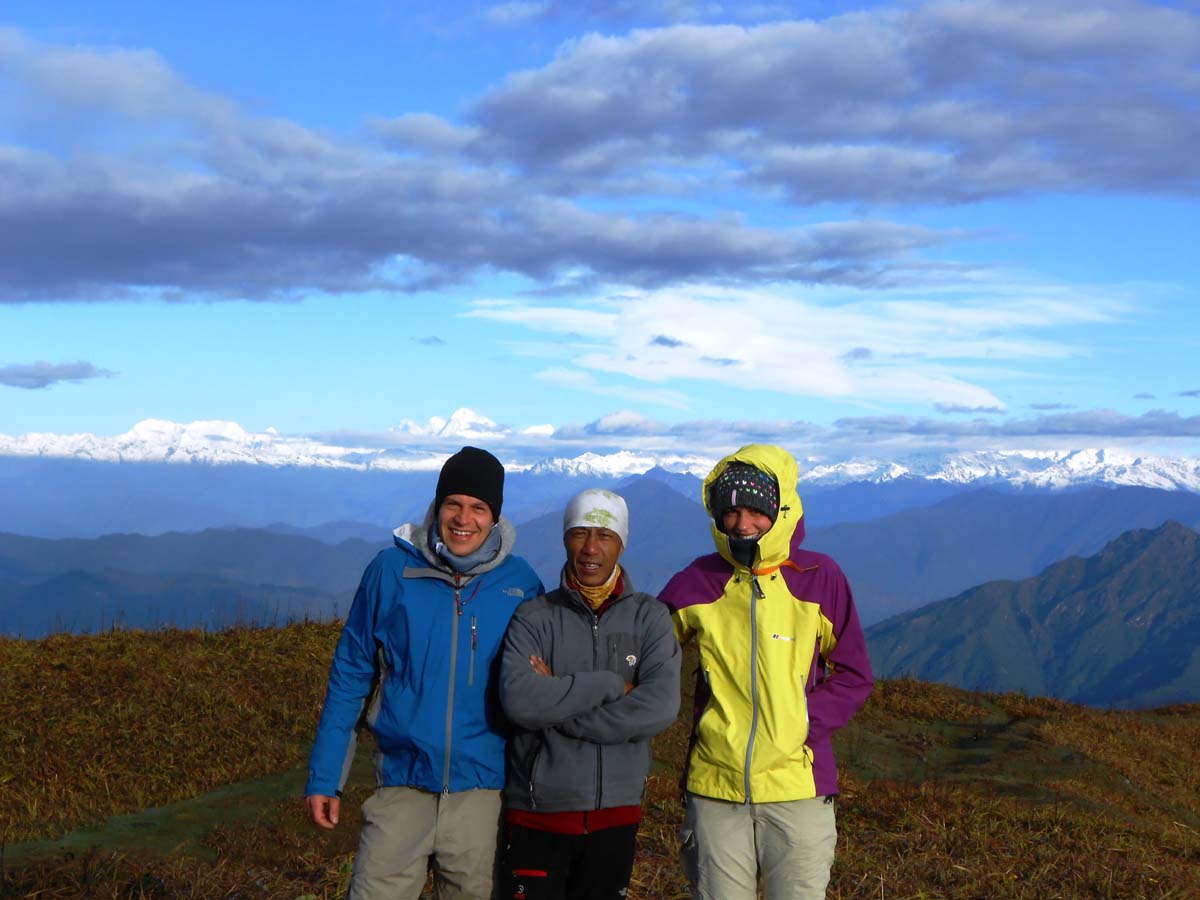
INDIA Farouttrek Upper Chiboo Approach Road, Kalimpong-734301 Call – Mr.Fabian Tamang + 91-9933975902 +91-6294972671 WhatsApp Us: +91-9933975902 Email Us: [email protected] [email protected]

SIKKIM DARJEELING NEPAL BHUTAN TIBET LADAKH
All Rights Reserved© https://www.farouttrek.com 1999–2024.

- Privacy Overview
- Strictly Necessary Cookies
This website uses cookies so that we can provide you with the best user experience possible. Cookie information is stored in your browser and performs functions such as recognising you when you return to our website and helping our team to understand which sections of the website you find most interesting and useful.
Strictly Necessary Cookie should be enabled at all times so that we can save your preferences for cookie settings.
If you disable this cookie, we will not be able to save your preferences. This means that every time you visit this website you will need to enable or disable cookies again.

Dates & Prices
Activity level, accommodations, india sikkim kanchenjunga ridge trekking tour, a remote route to the world's third-highest mountain, from: $6,995.
- Available: October, November
- Activity: Level 5
- Accommodations: Comfortable Hotels, Luxury Hotels, Comfortable Camping
- --> --> Group Size: --> -->